
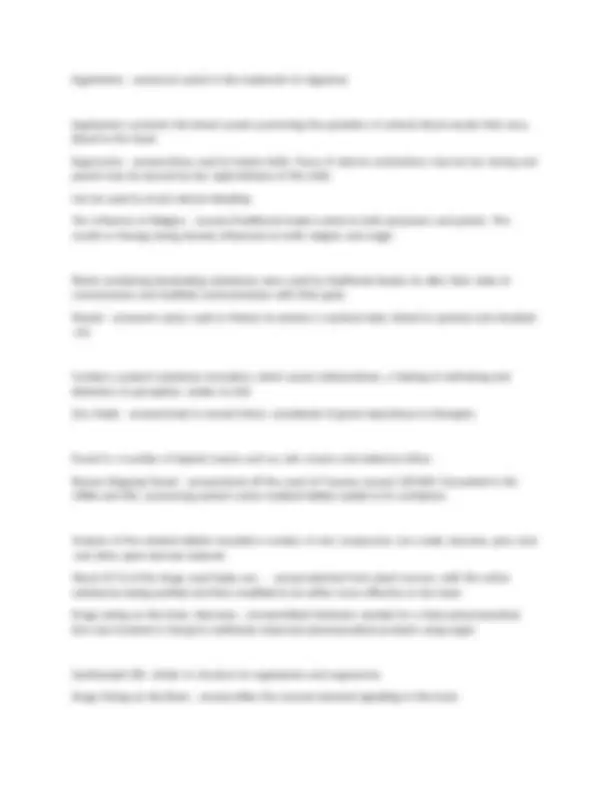
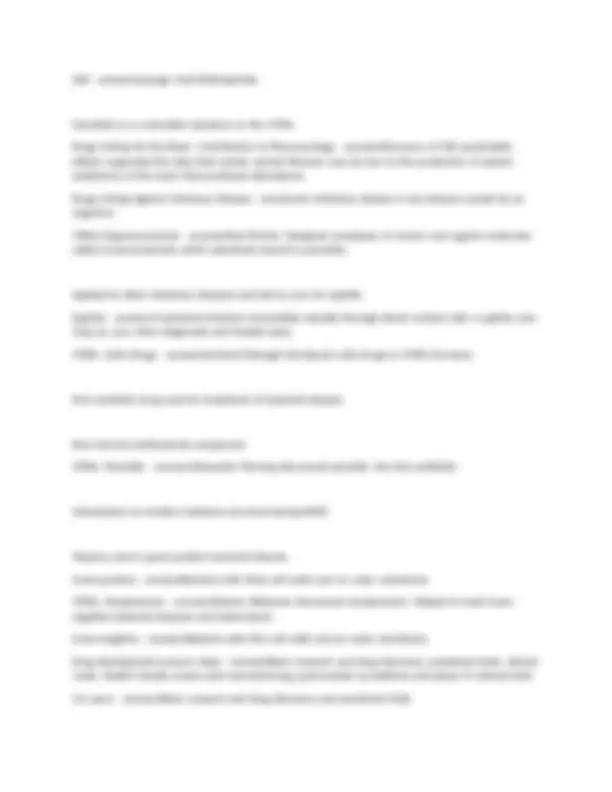
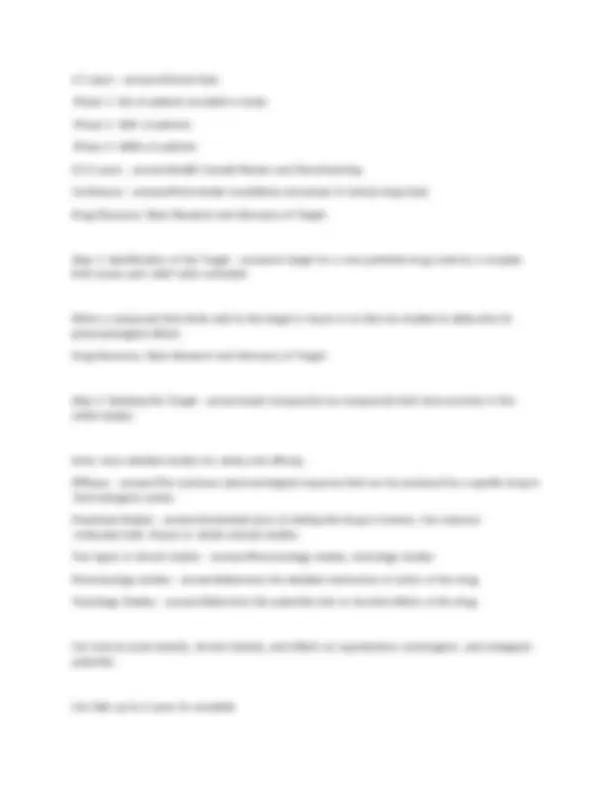
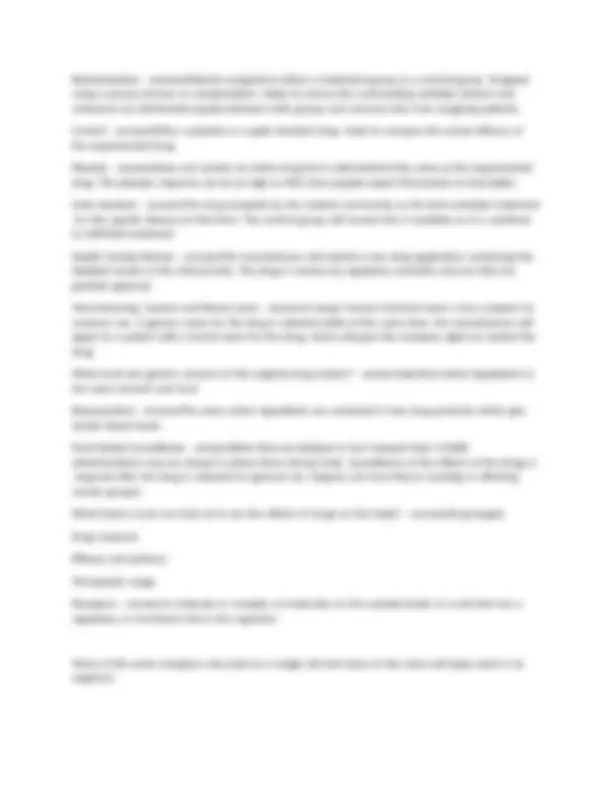
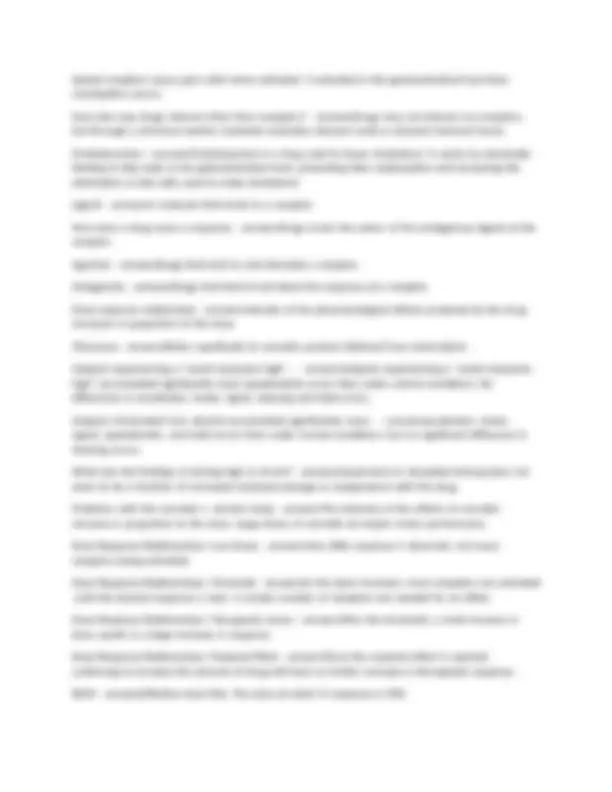
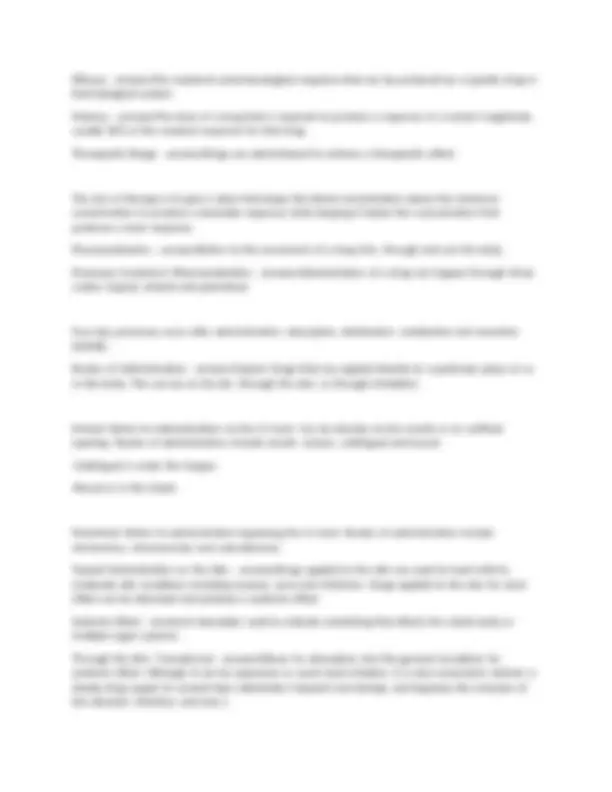
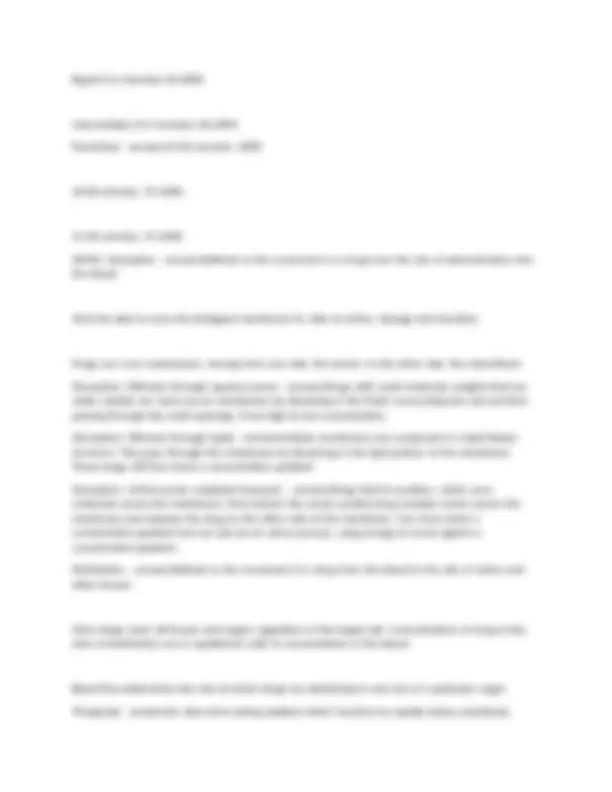


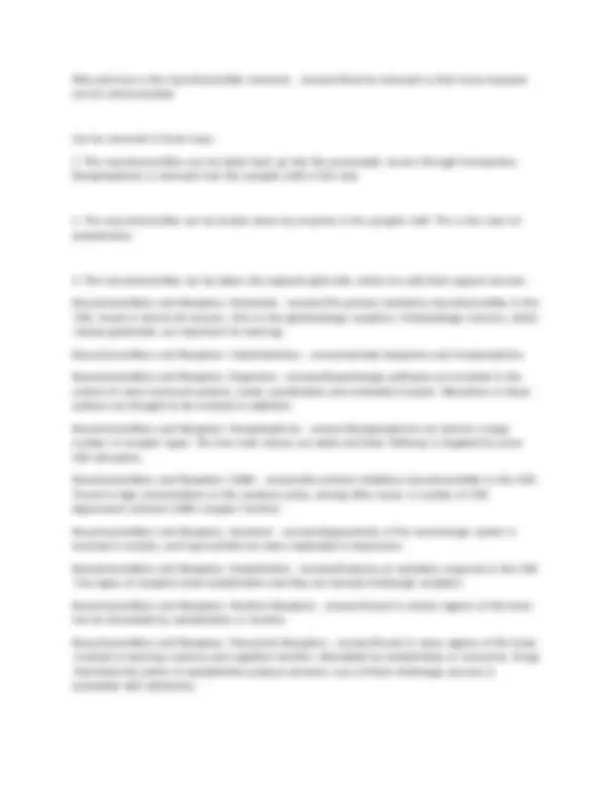
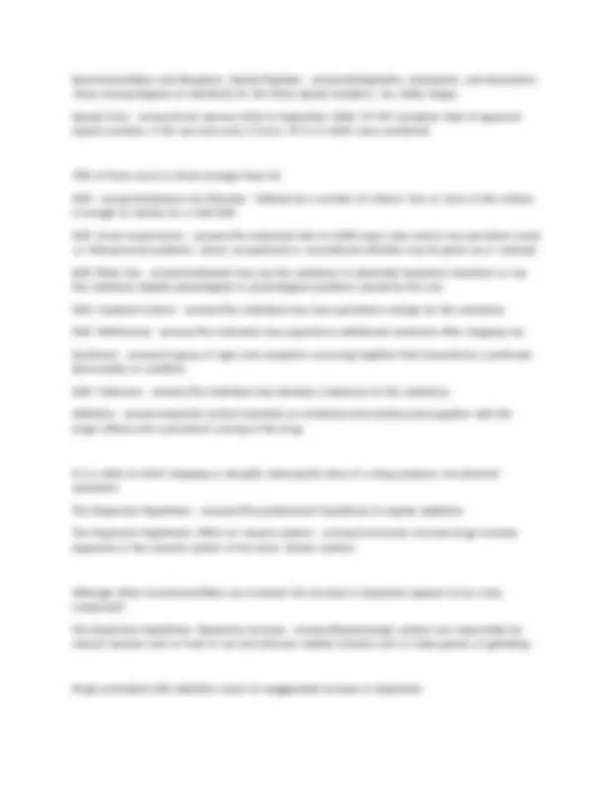
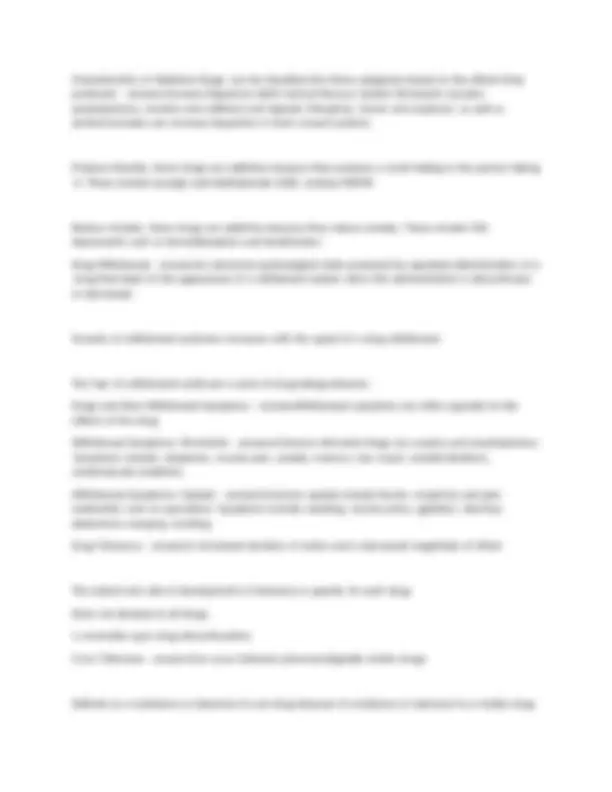
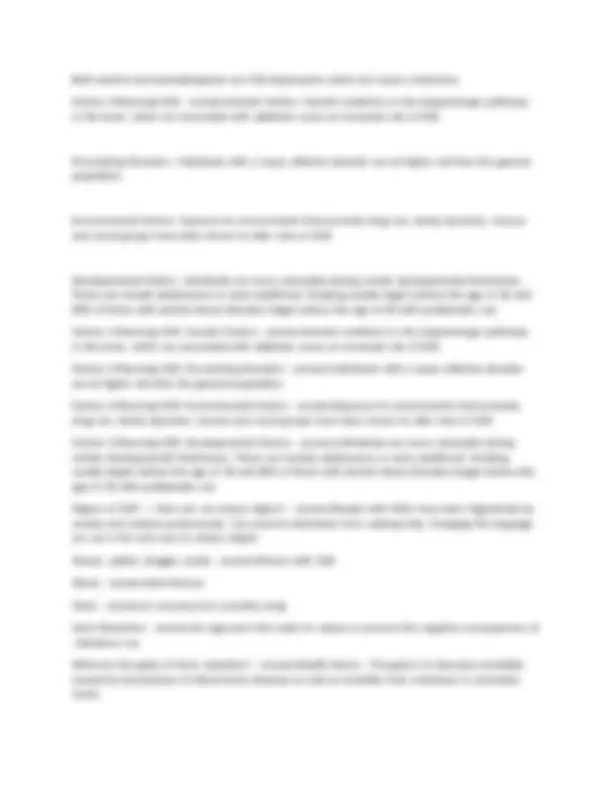
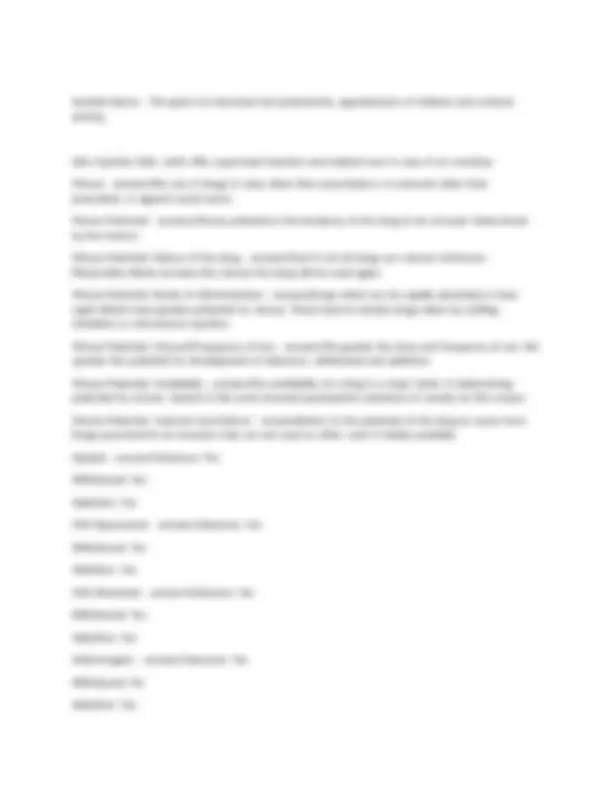
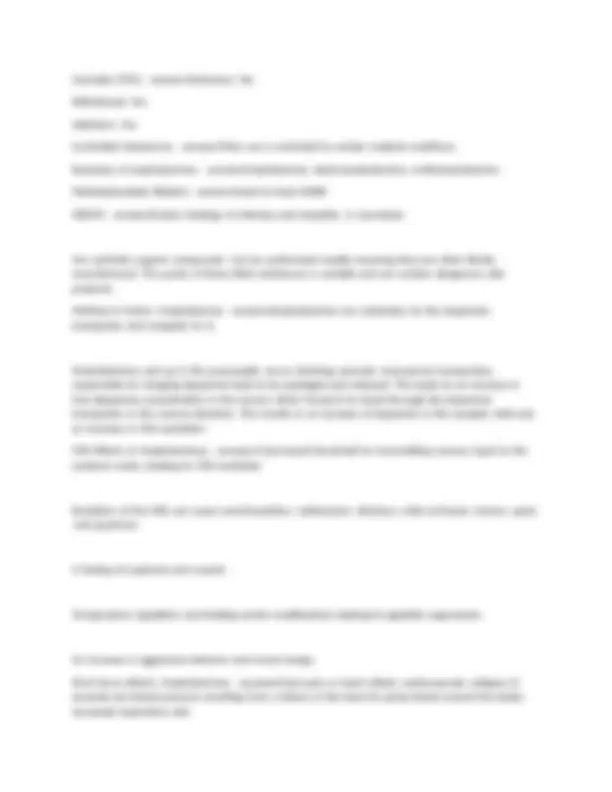
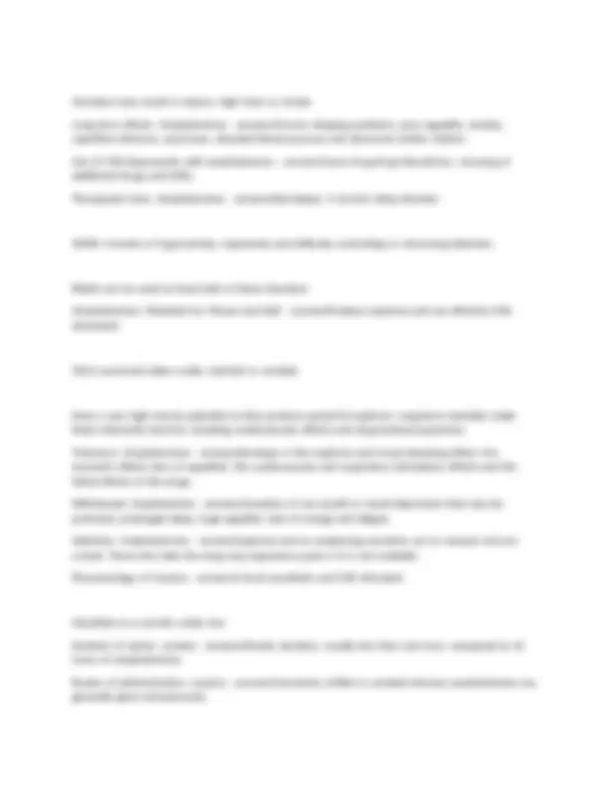
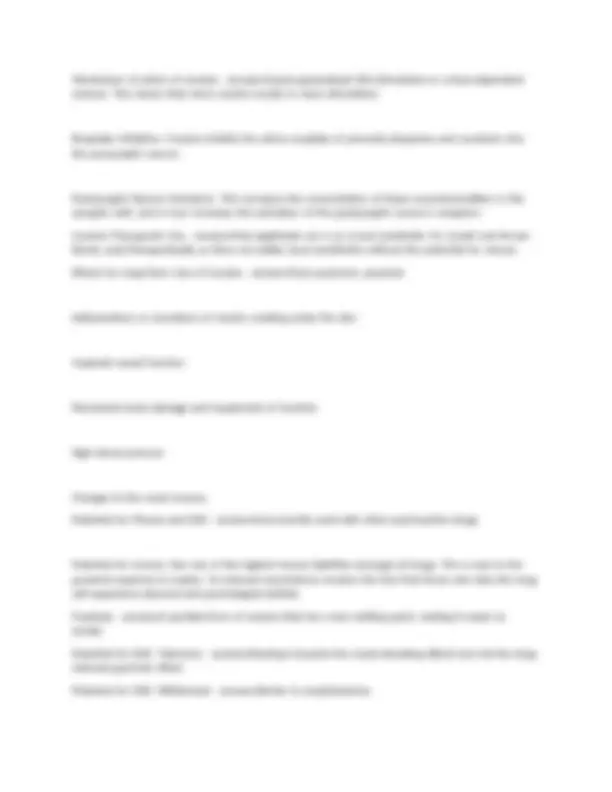
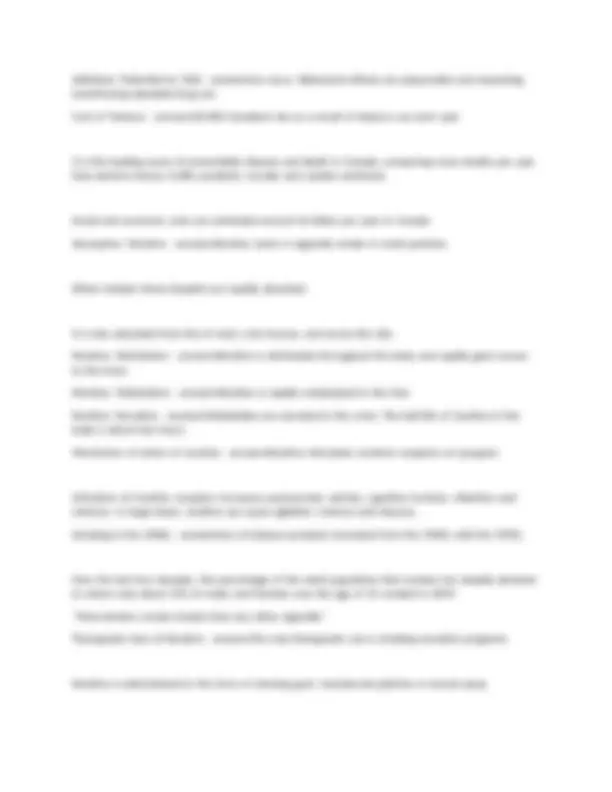
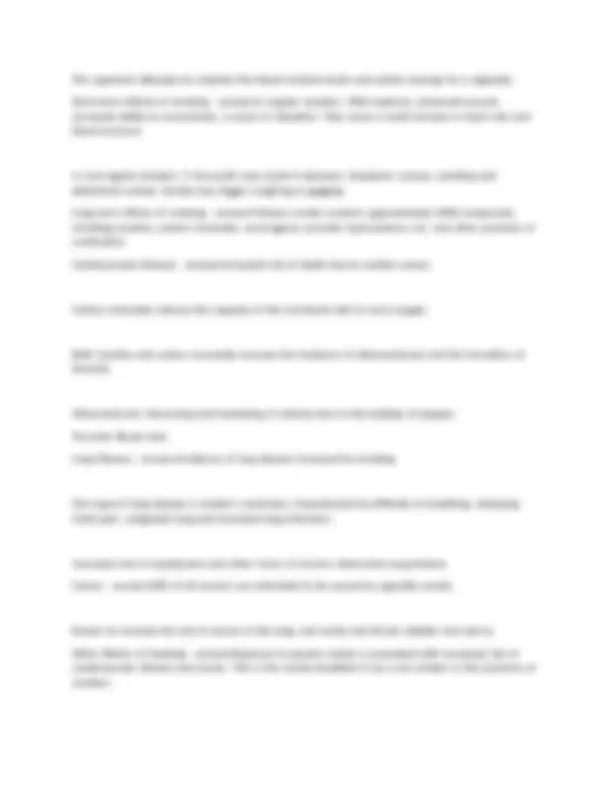
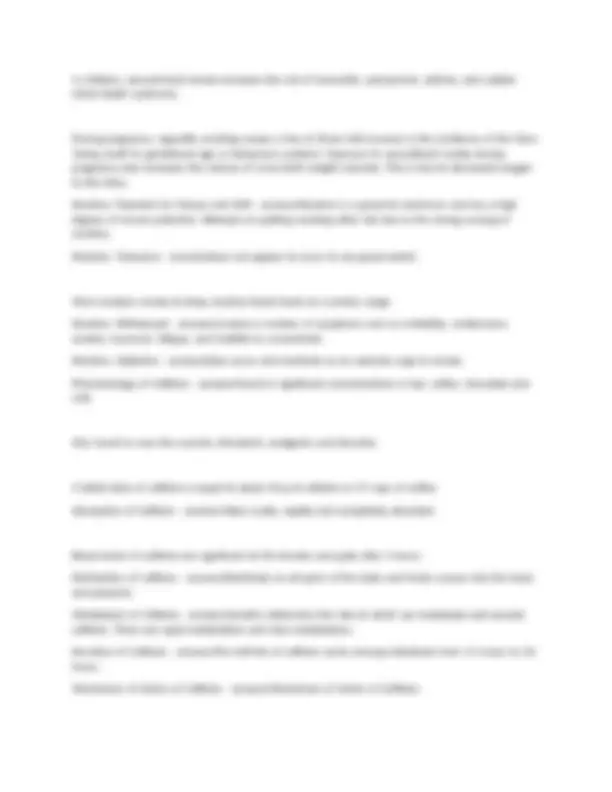
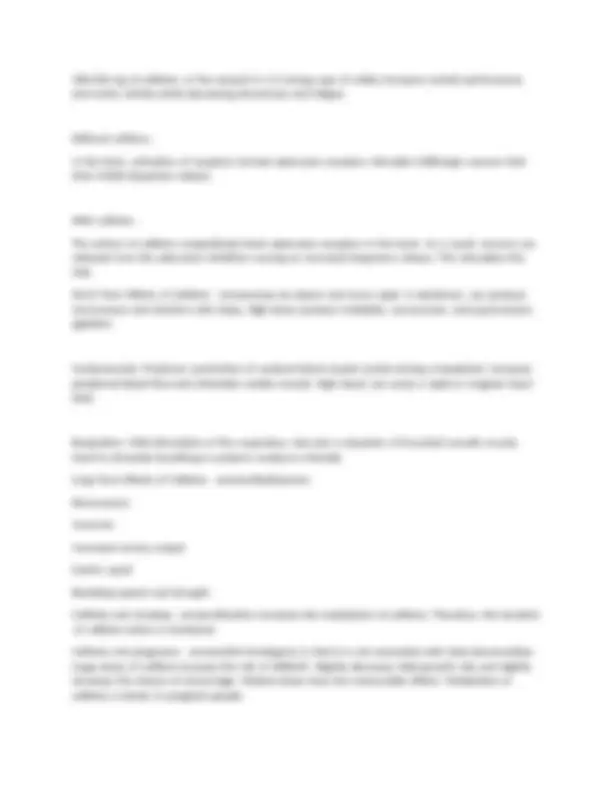
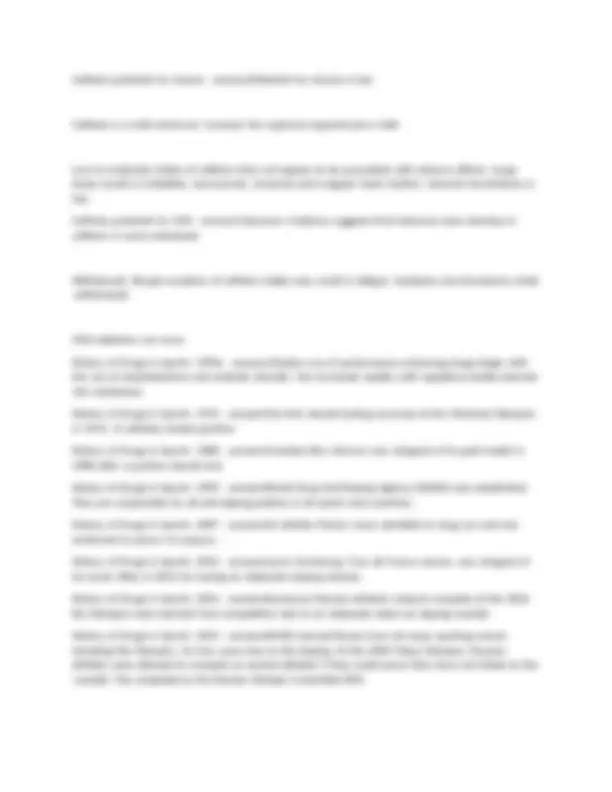

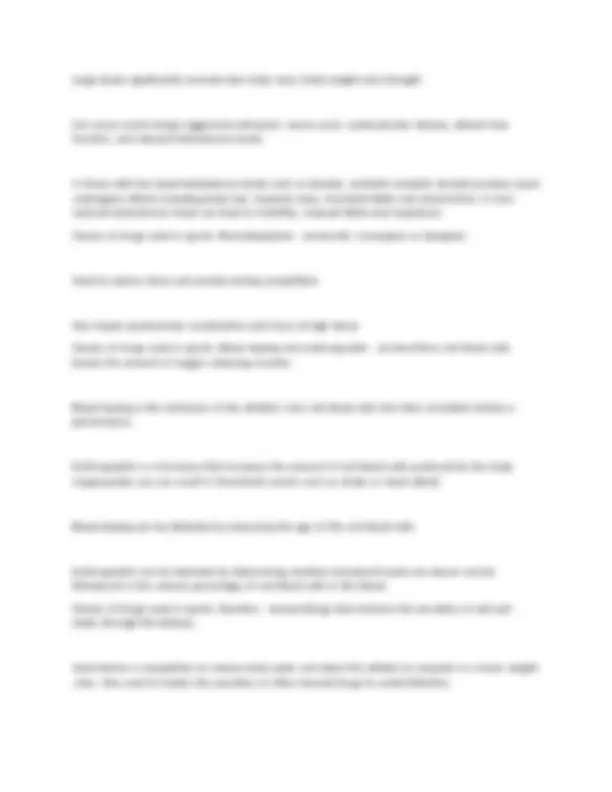
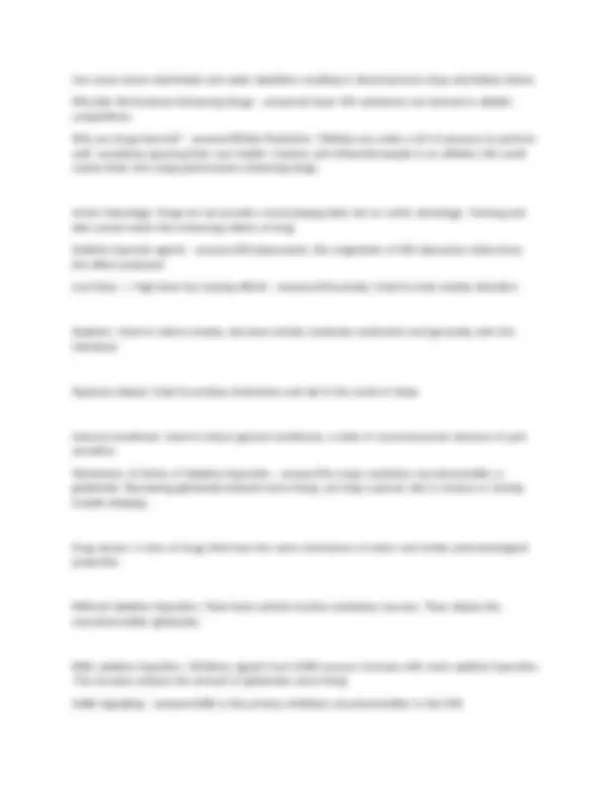
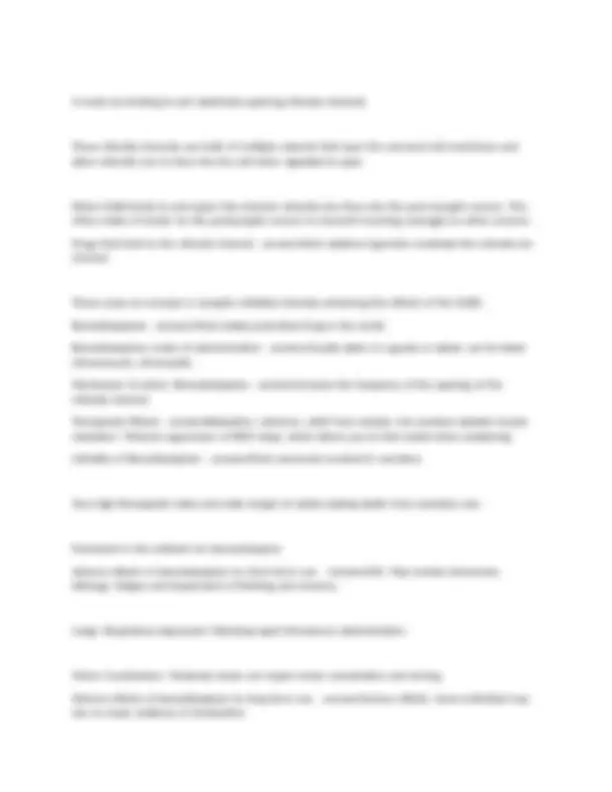
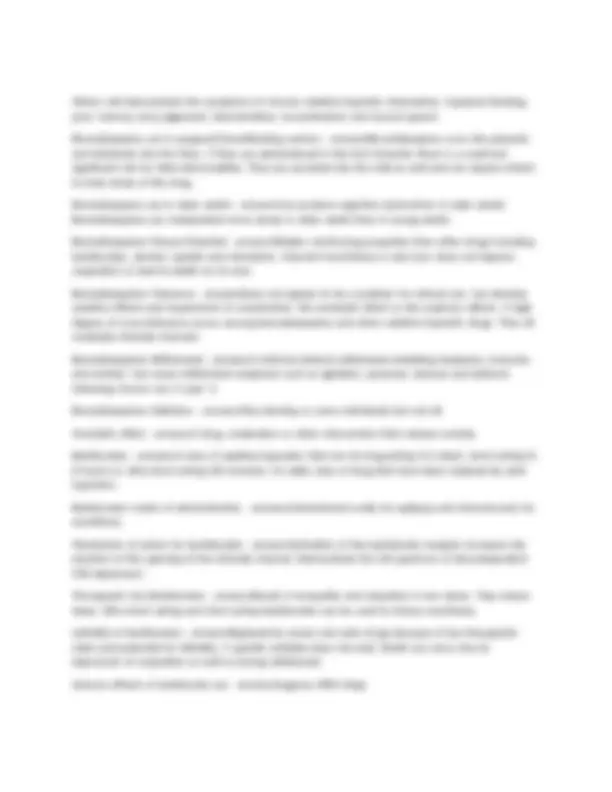
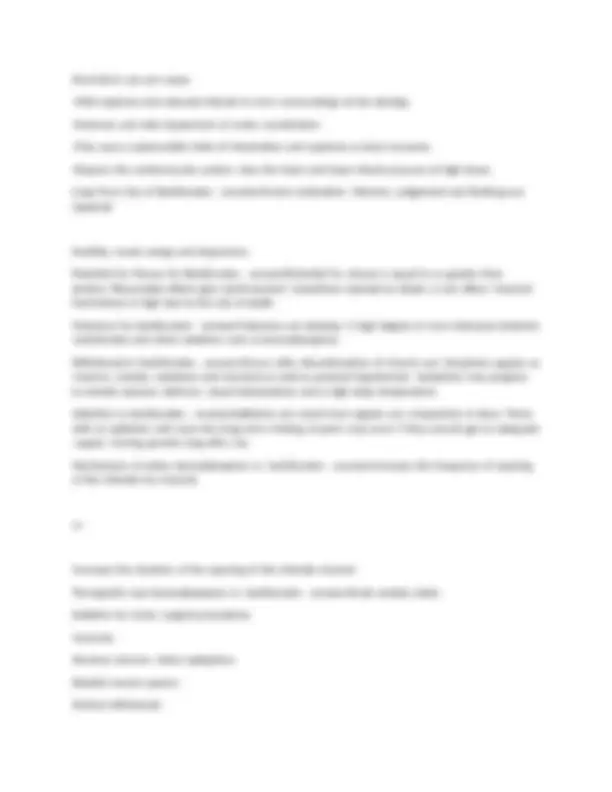
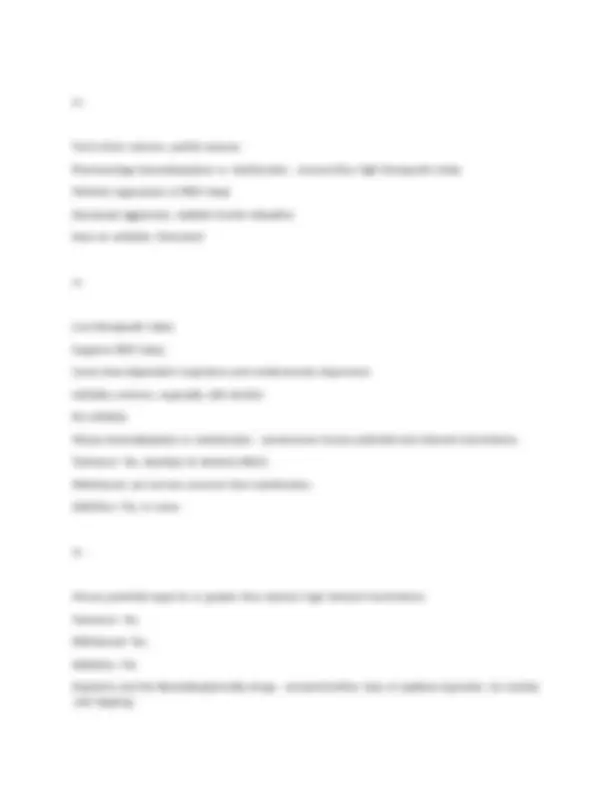
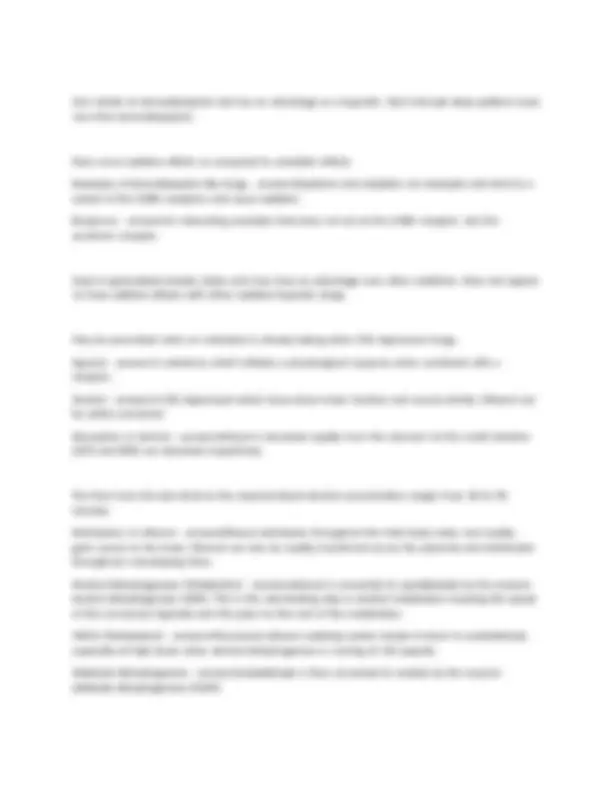

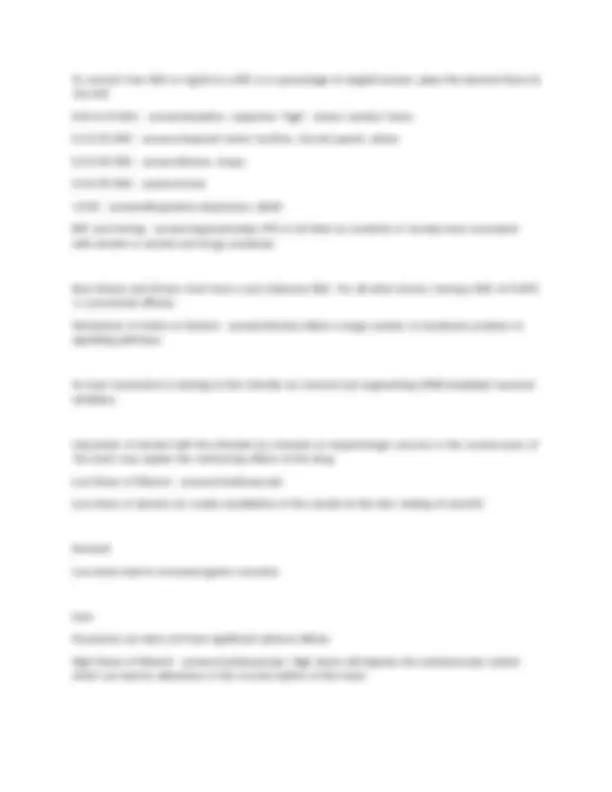
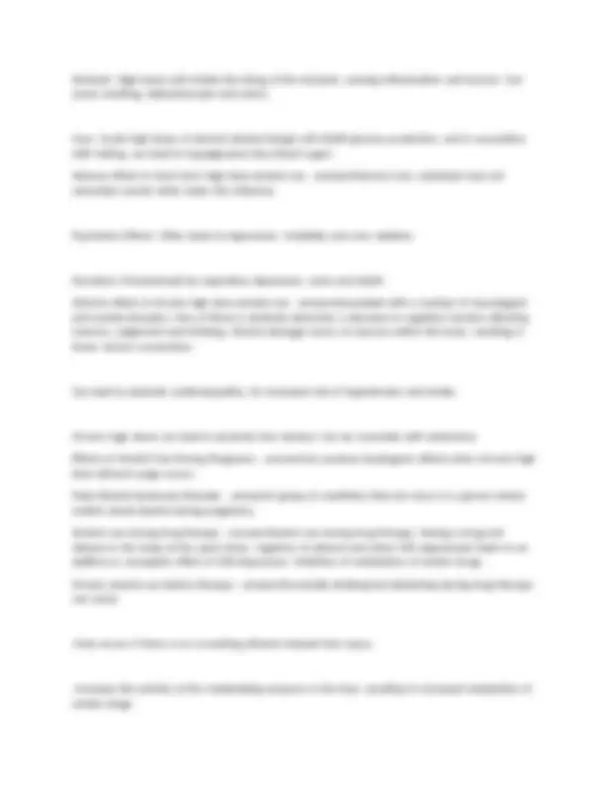
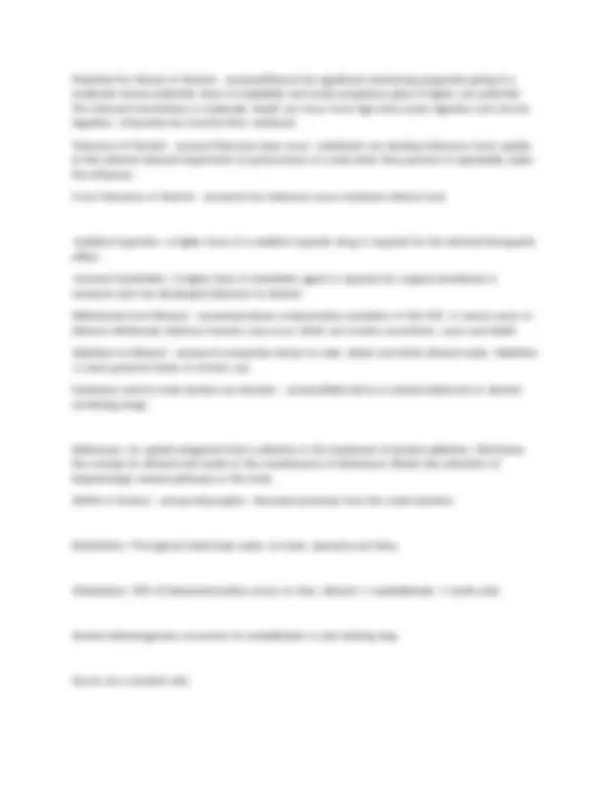
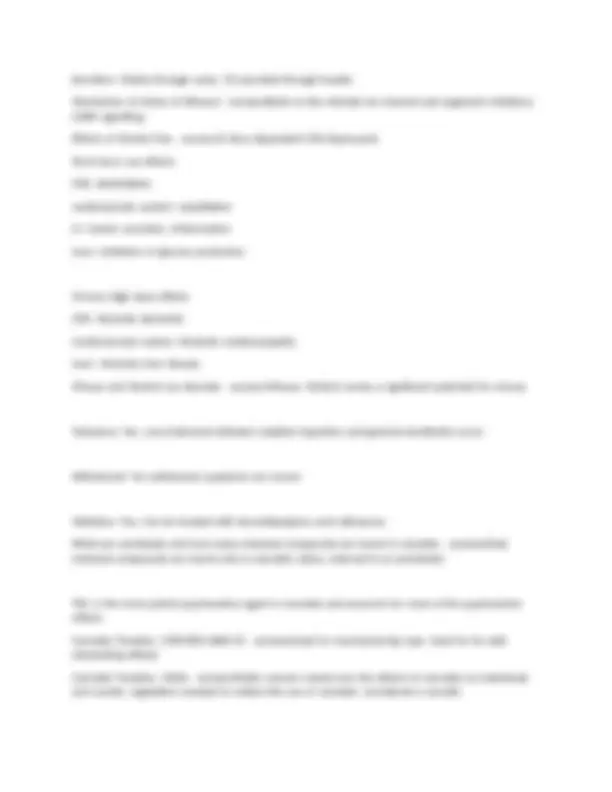
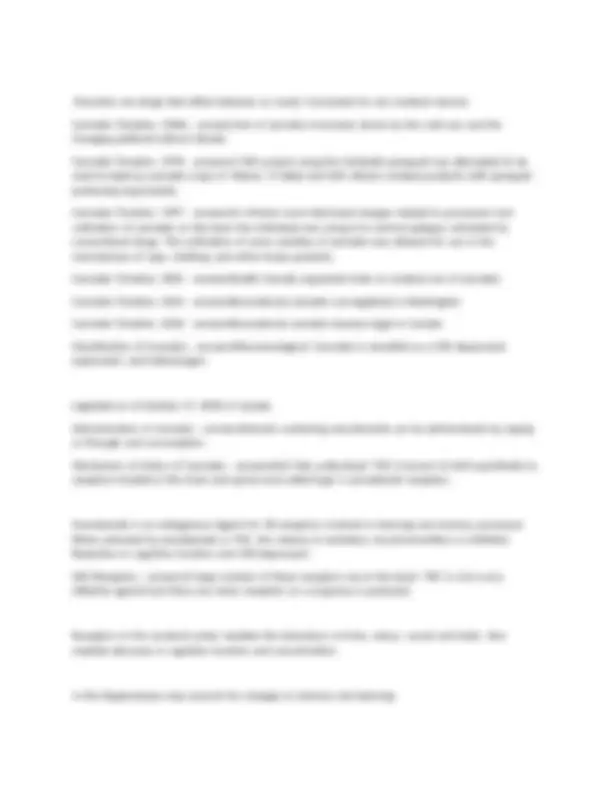
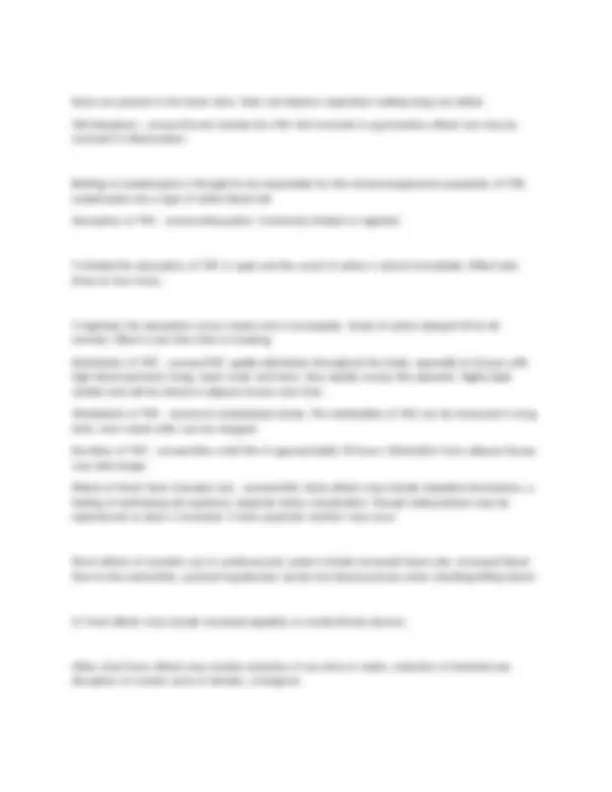
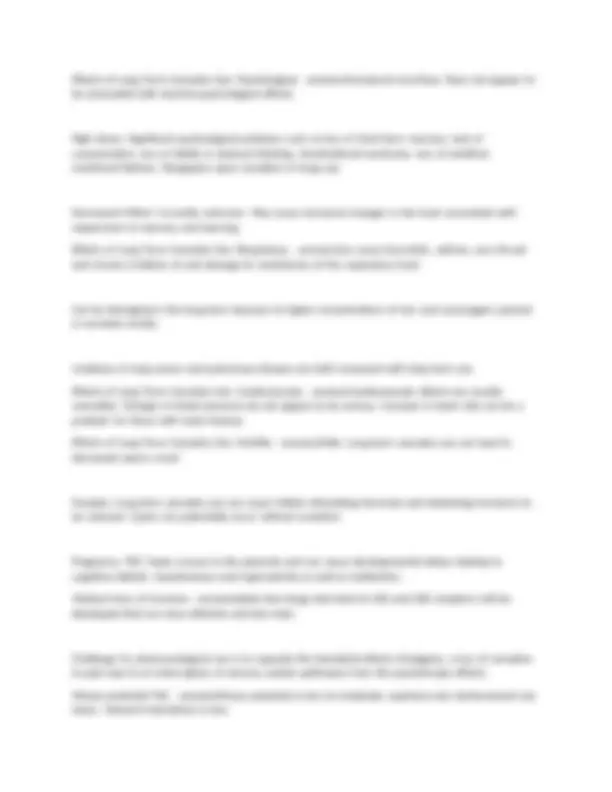
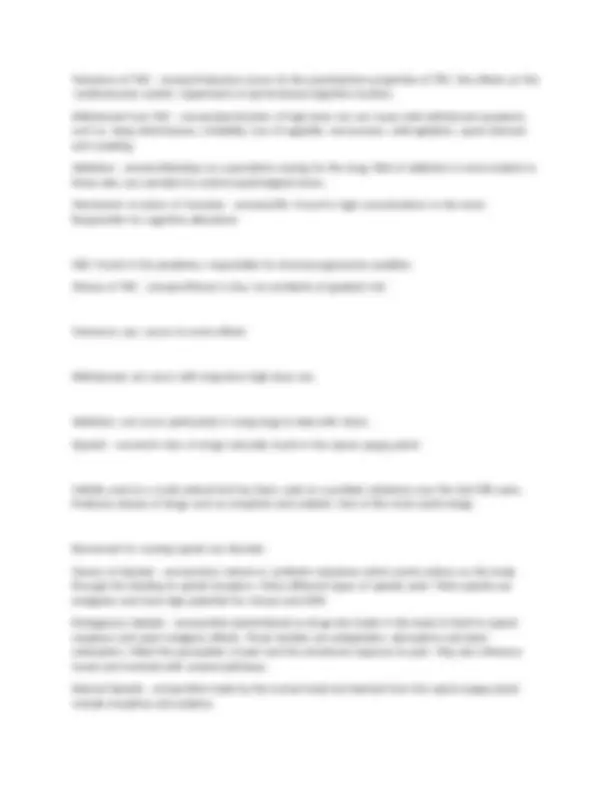
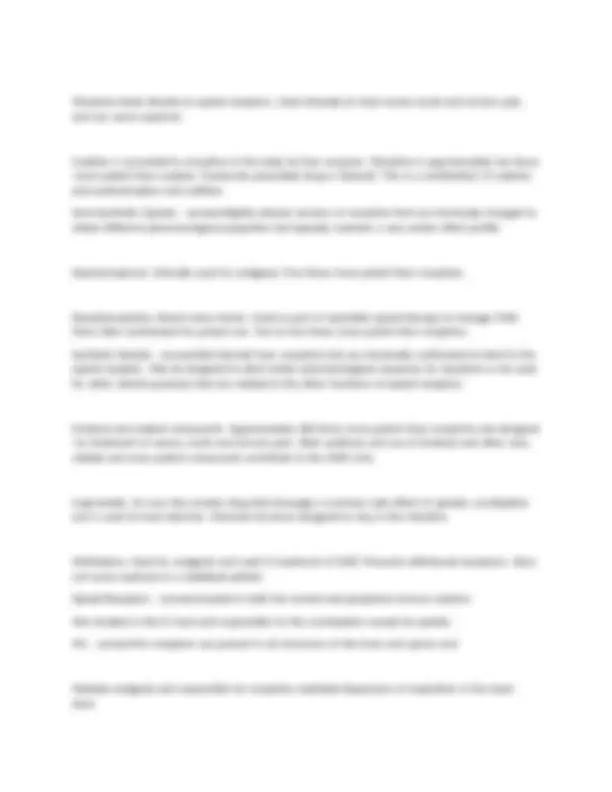
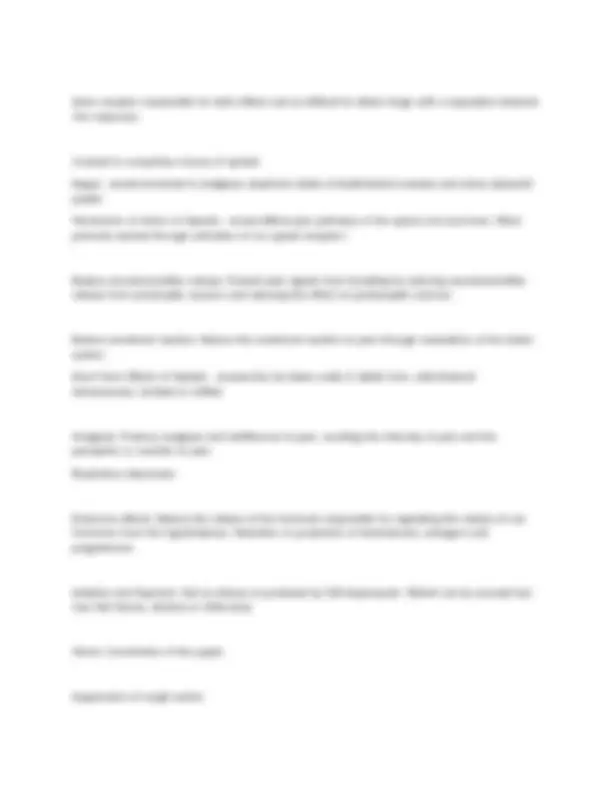
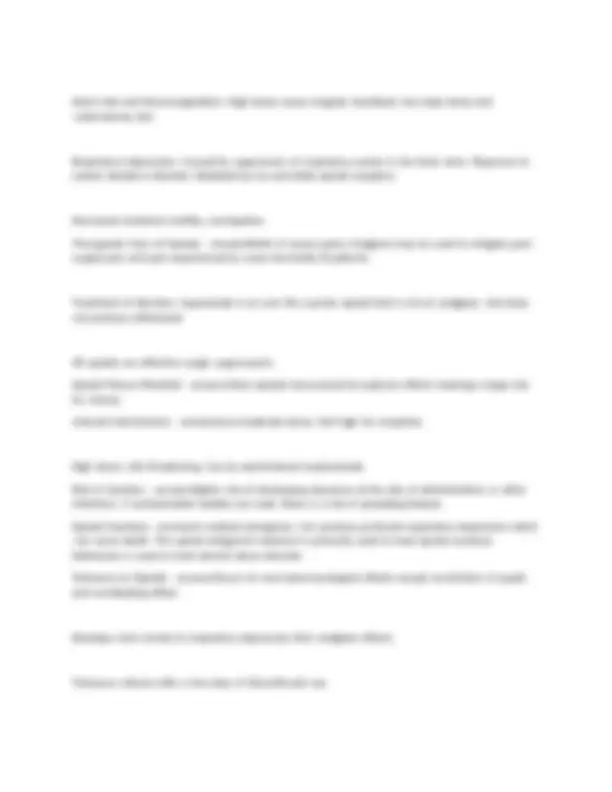
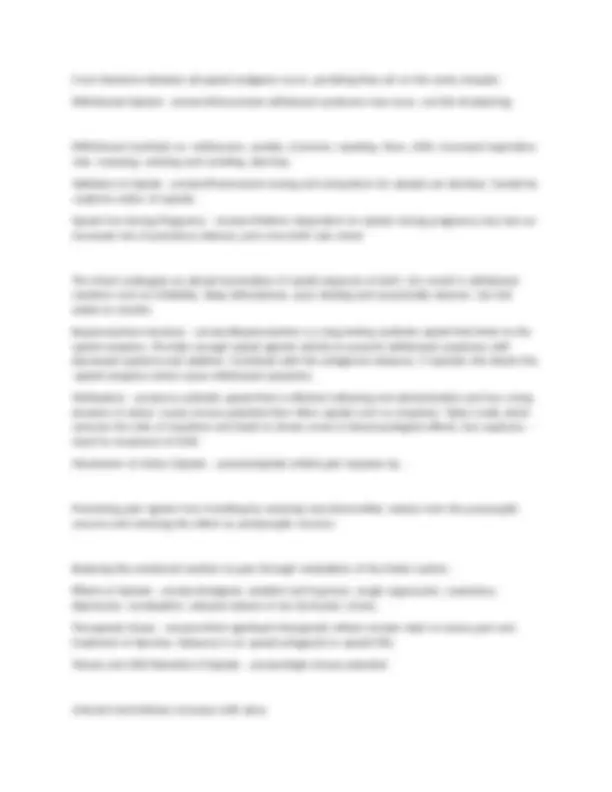
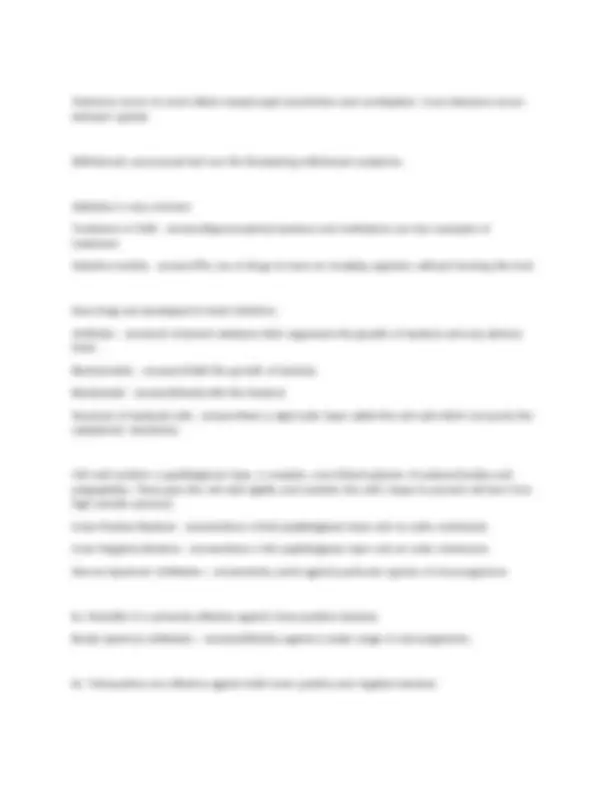
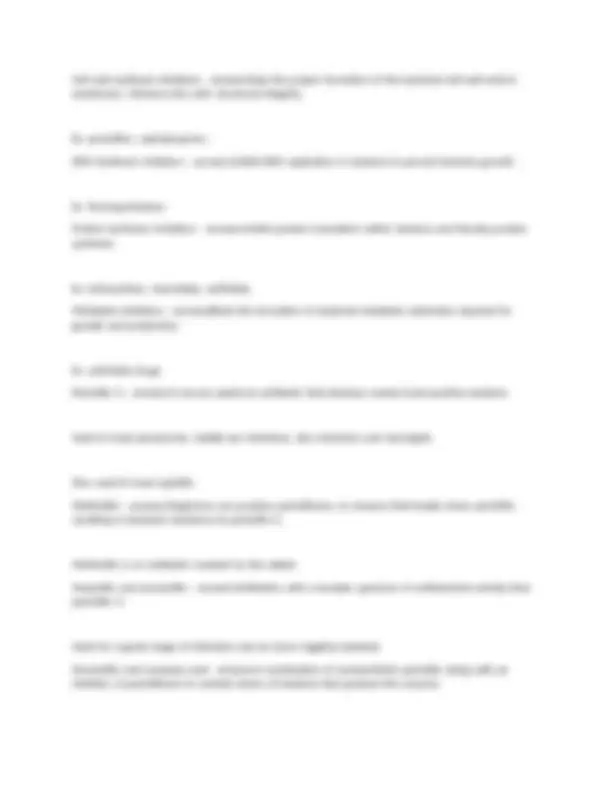
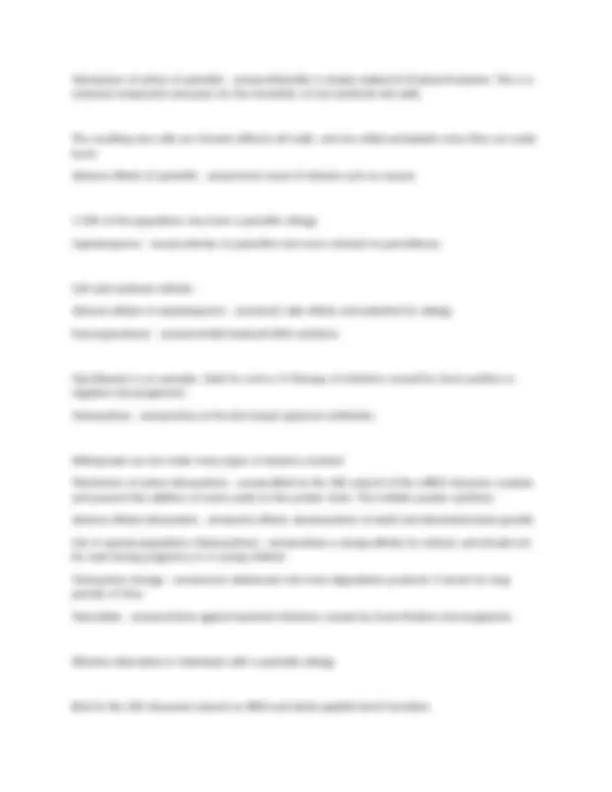
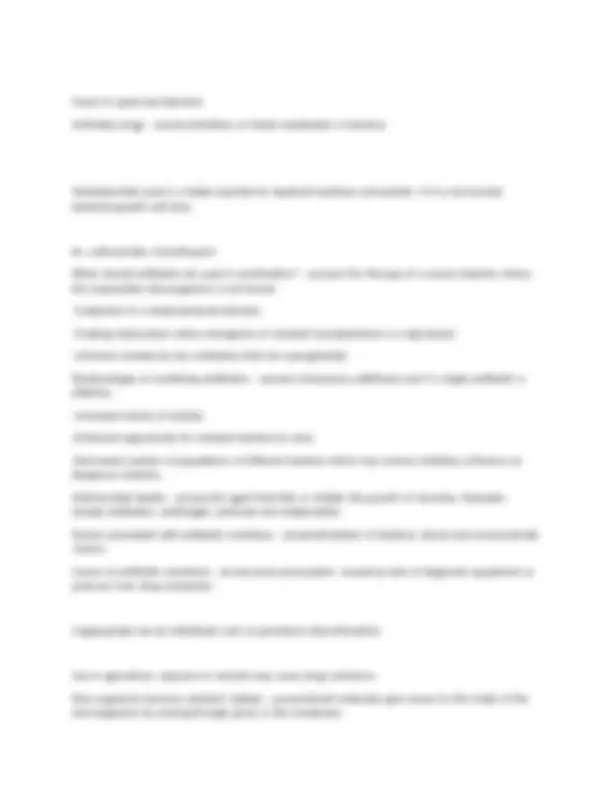
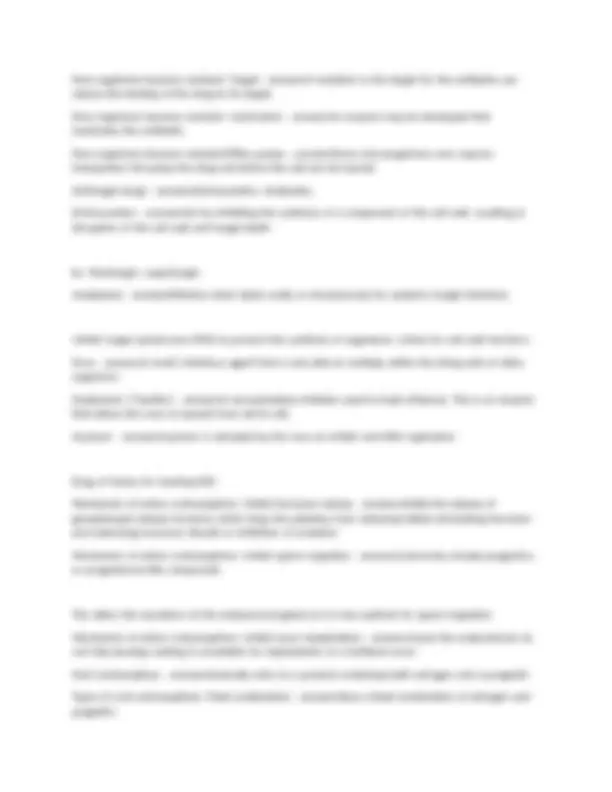
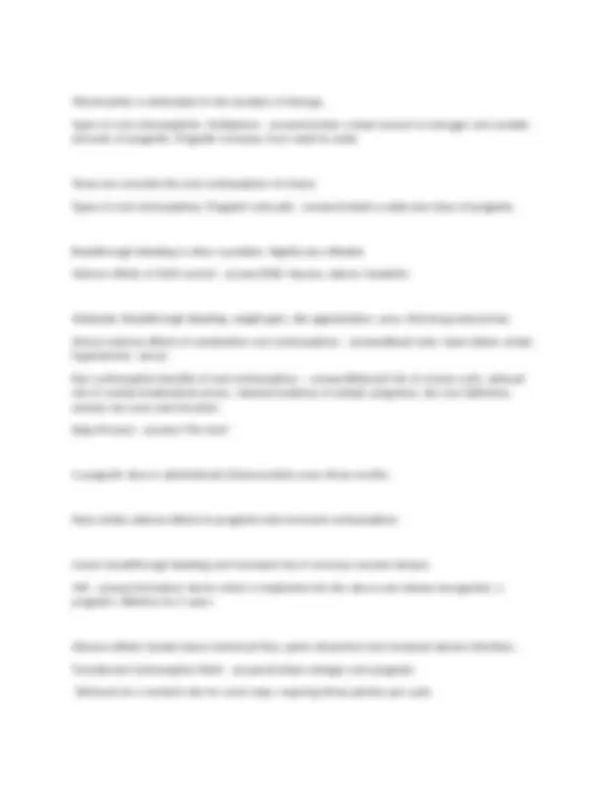
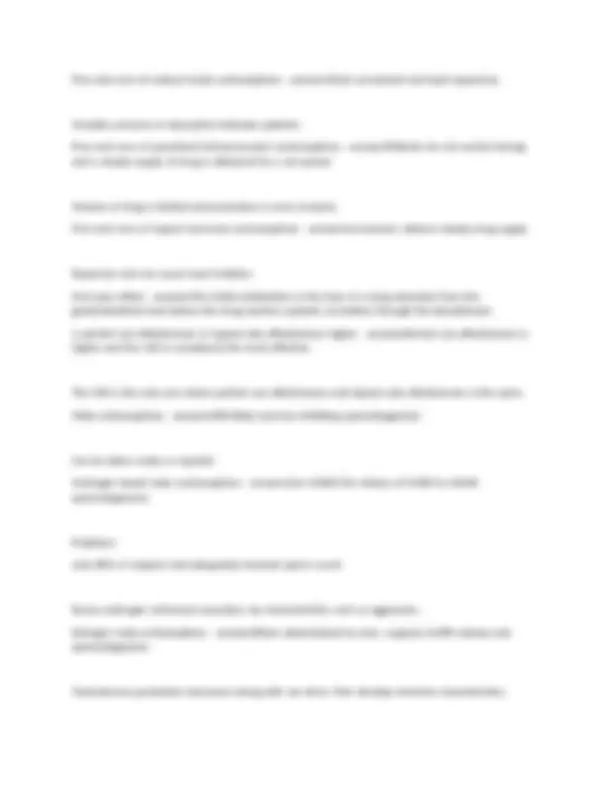
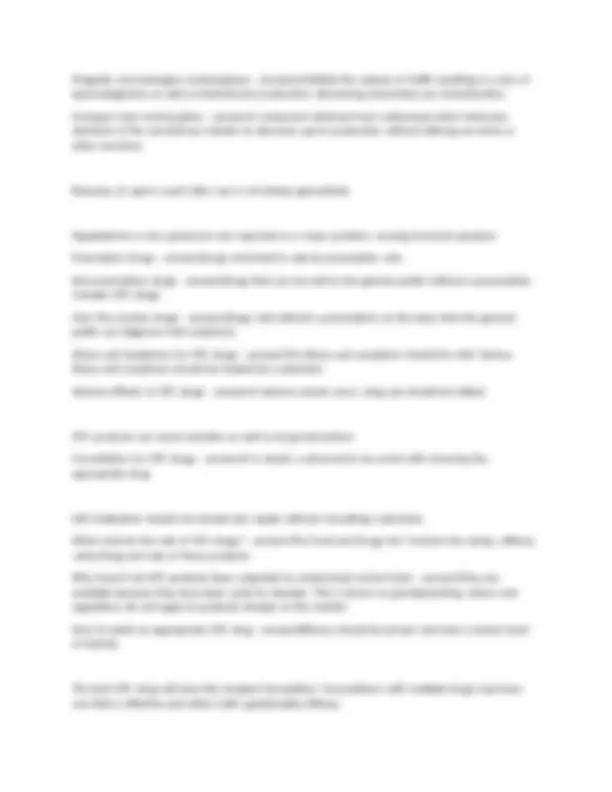
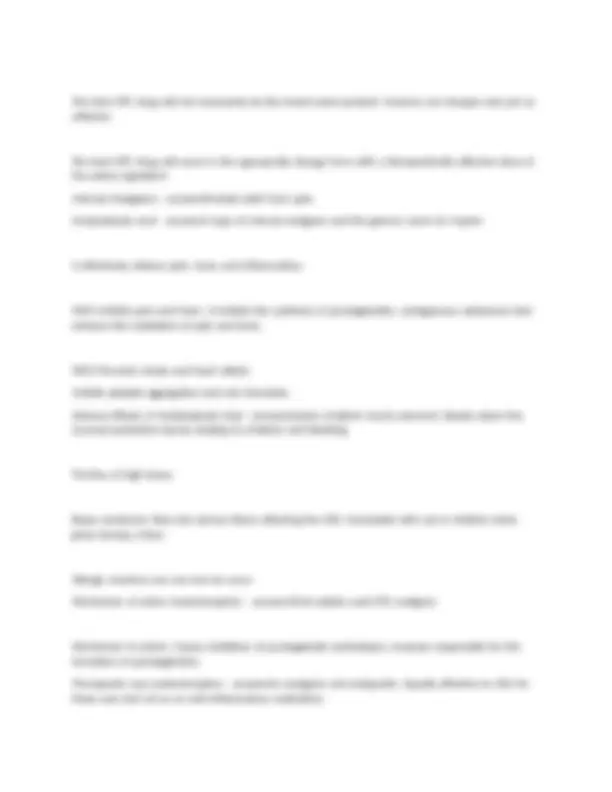
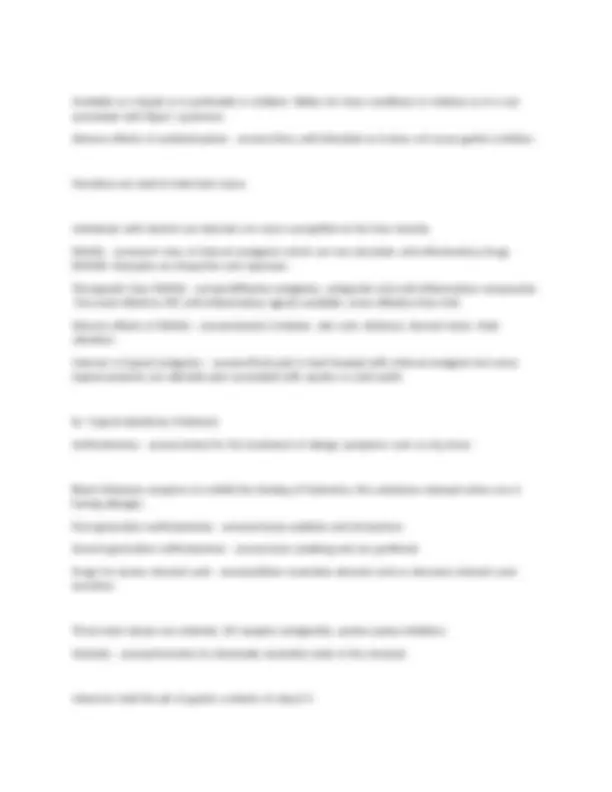
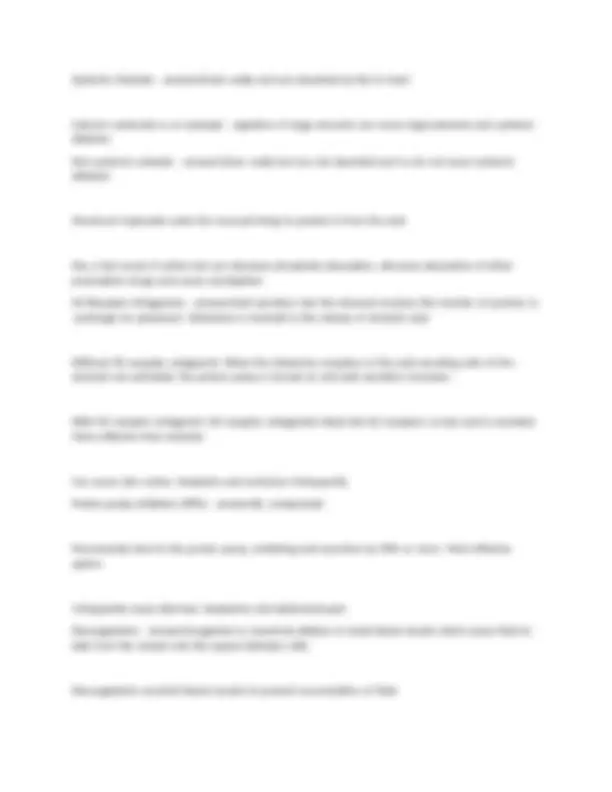
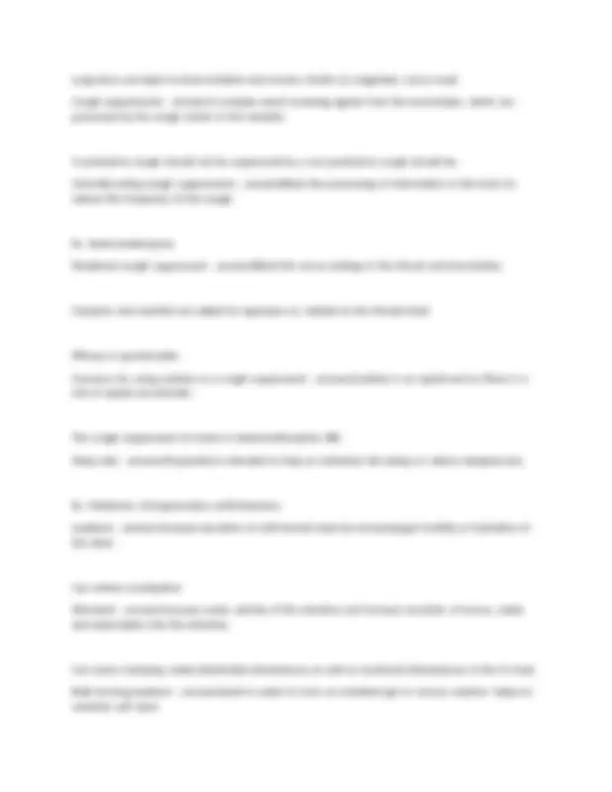
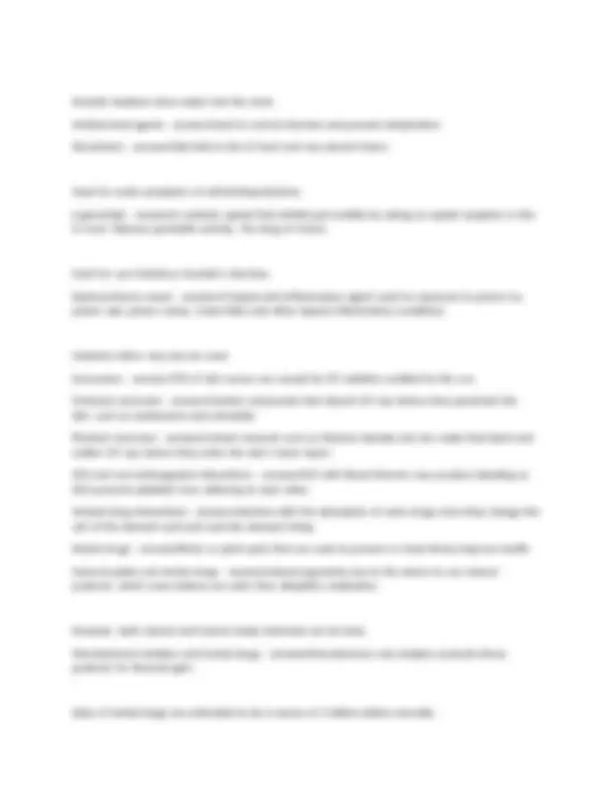
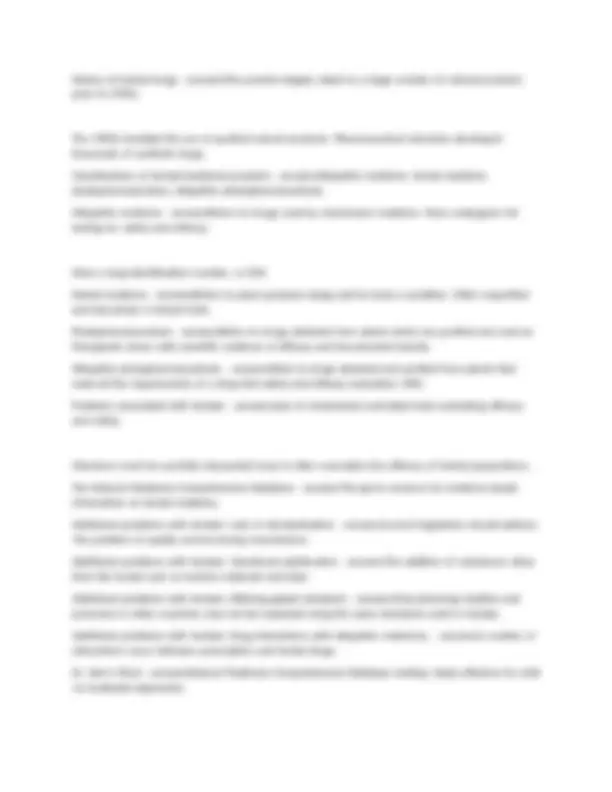
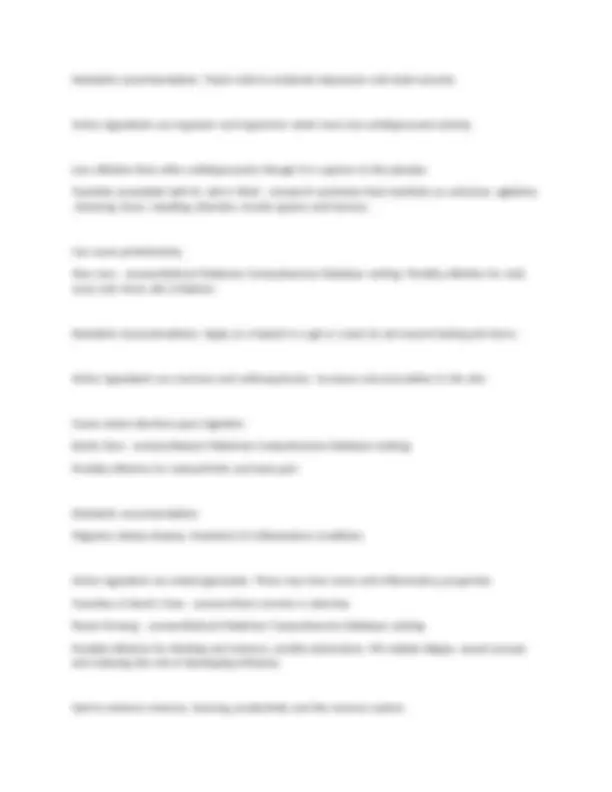
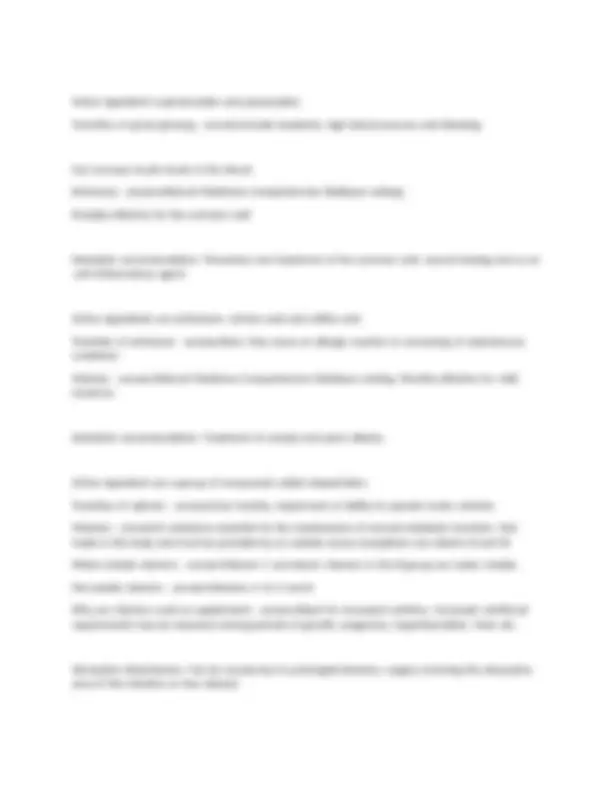
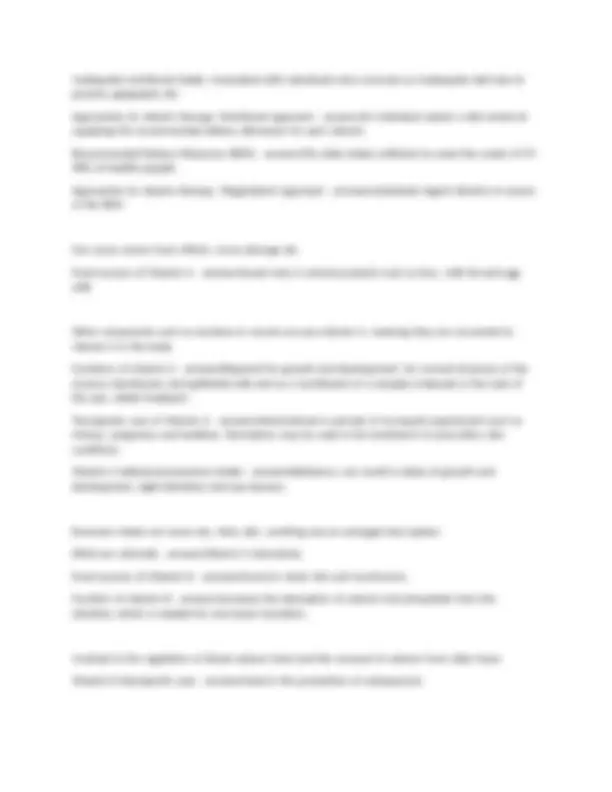
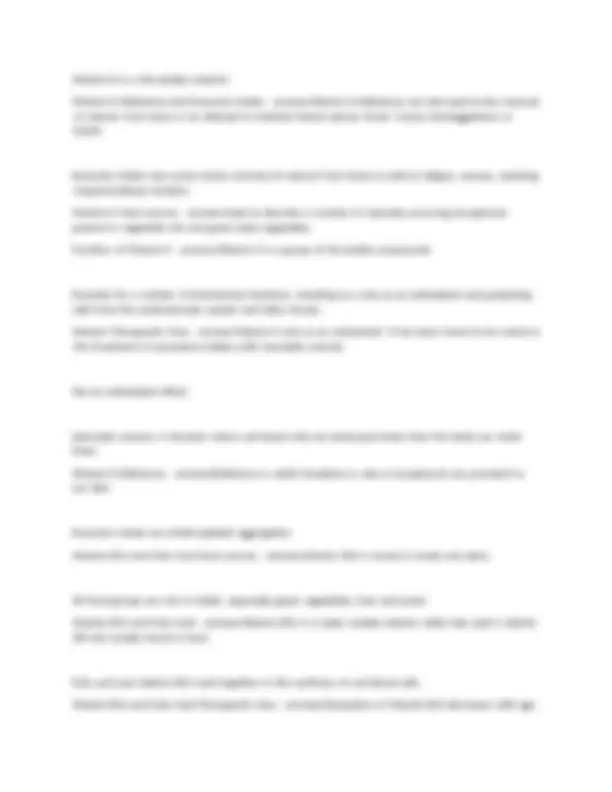
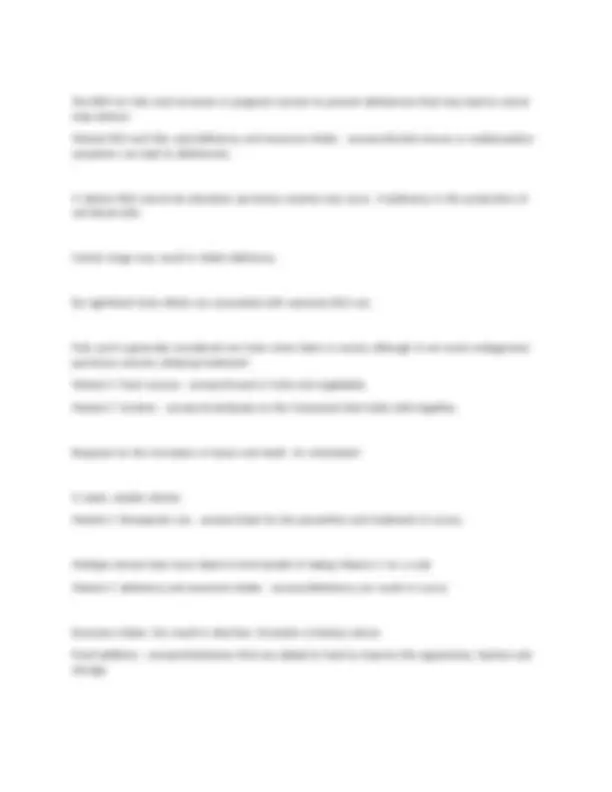
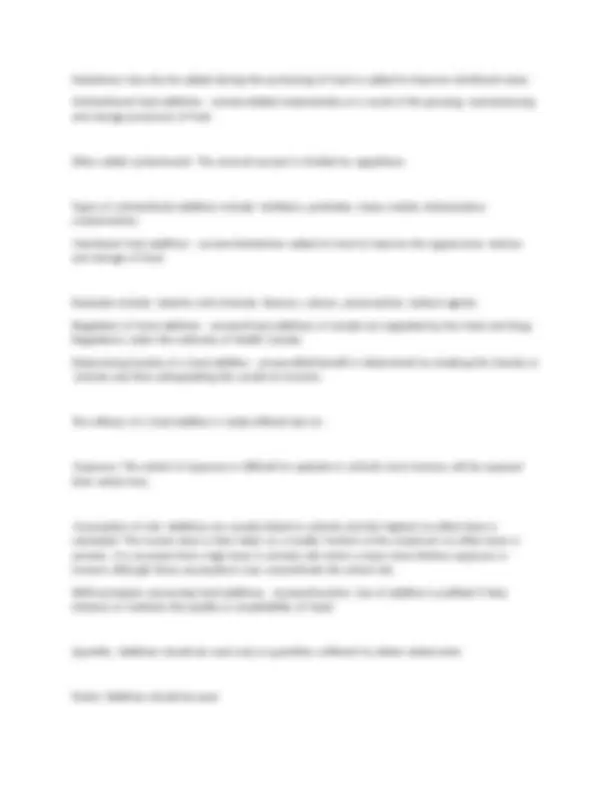
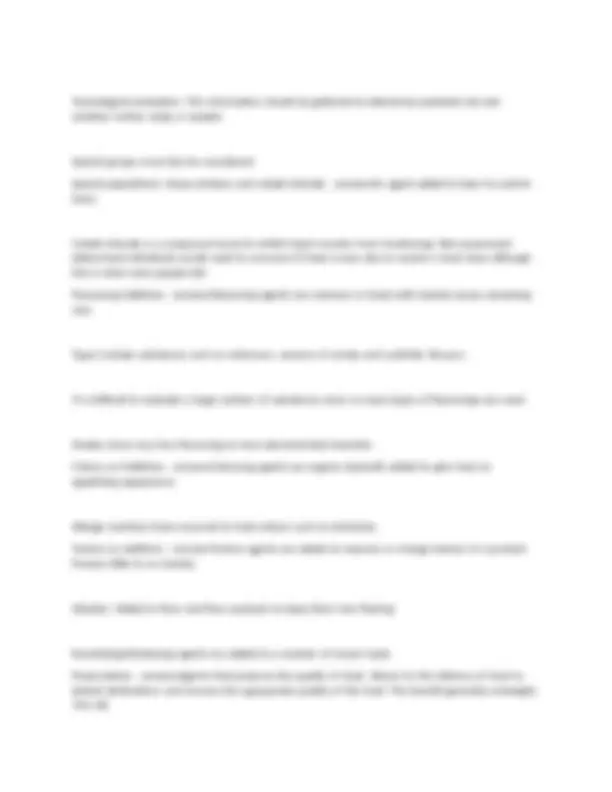
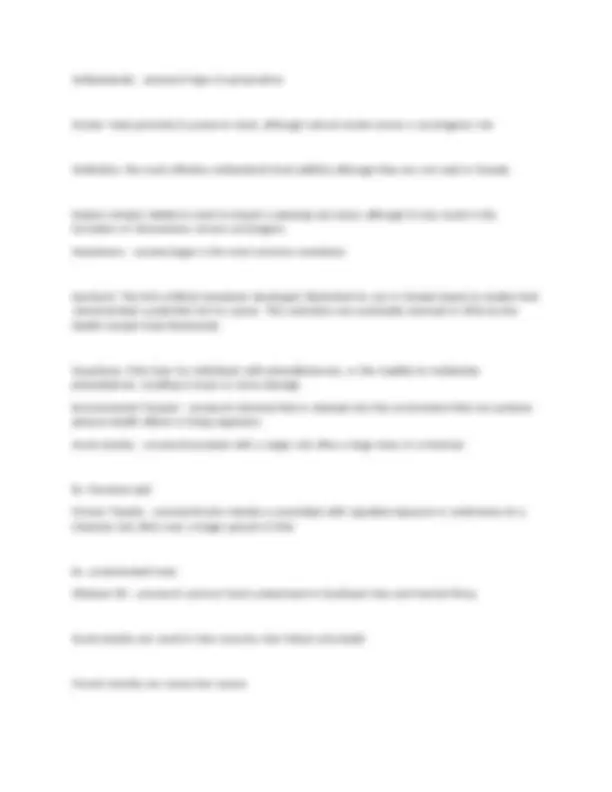
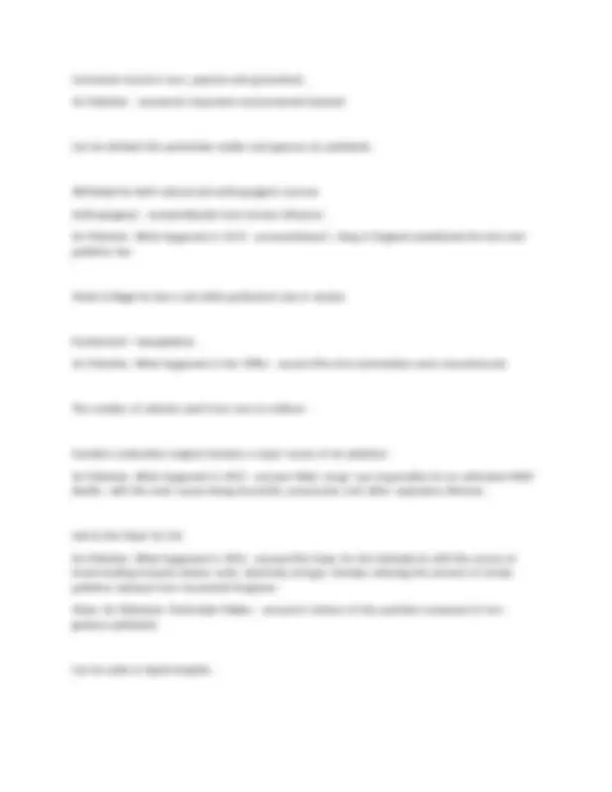
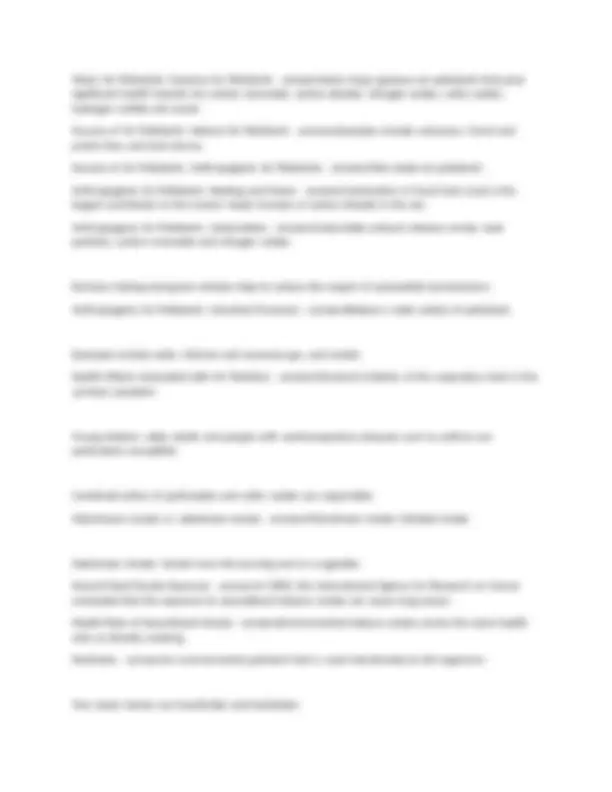
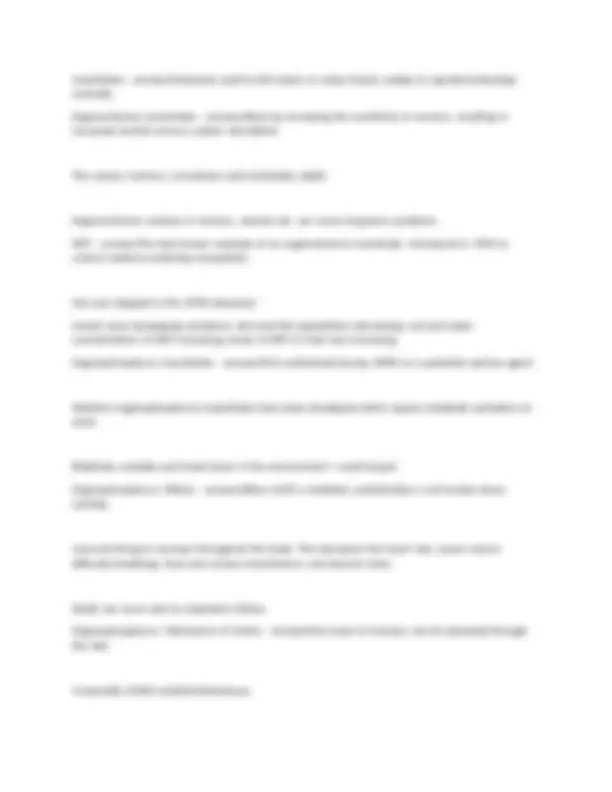
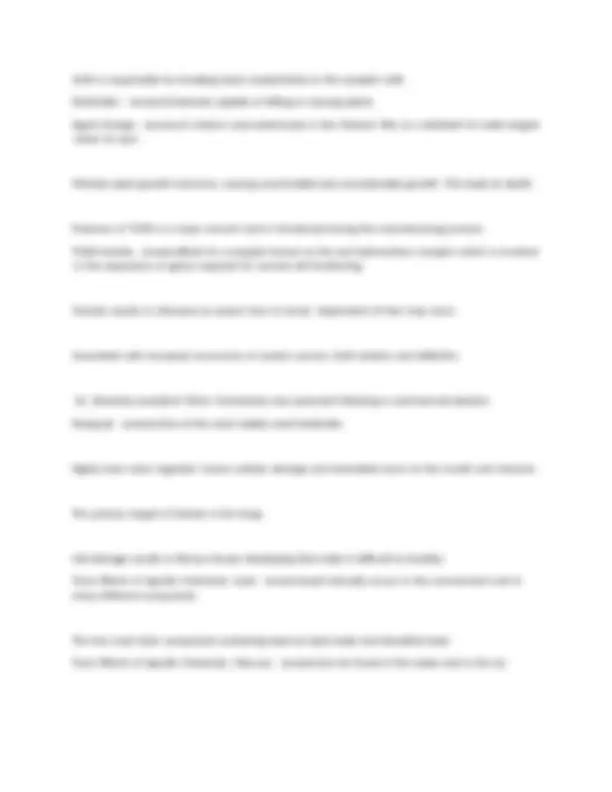
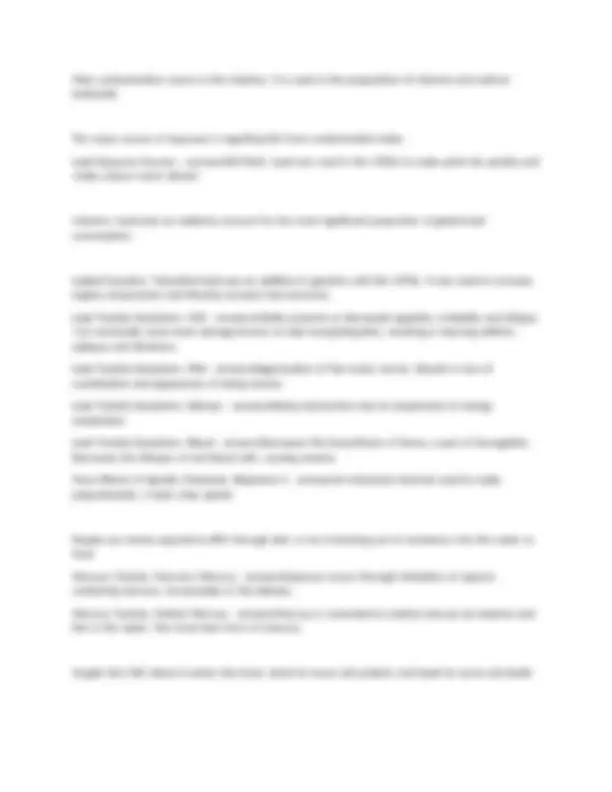
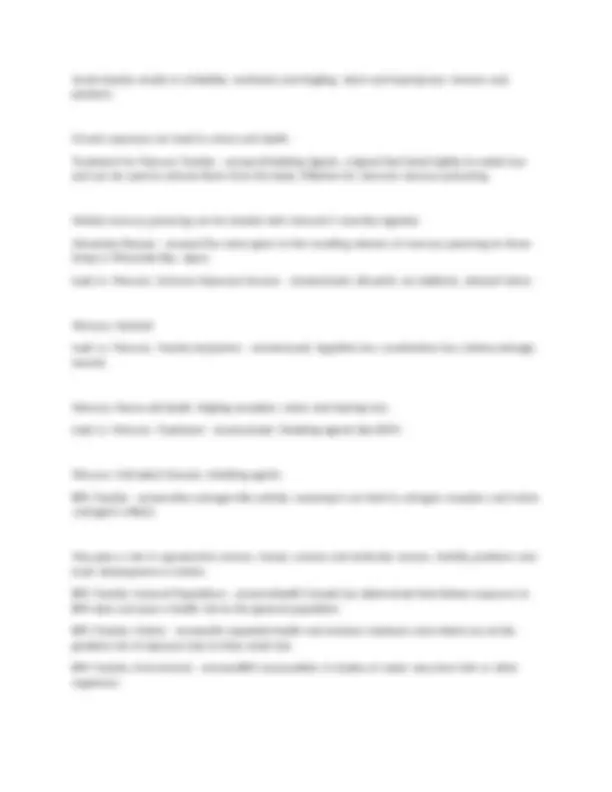
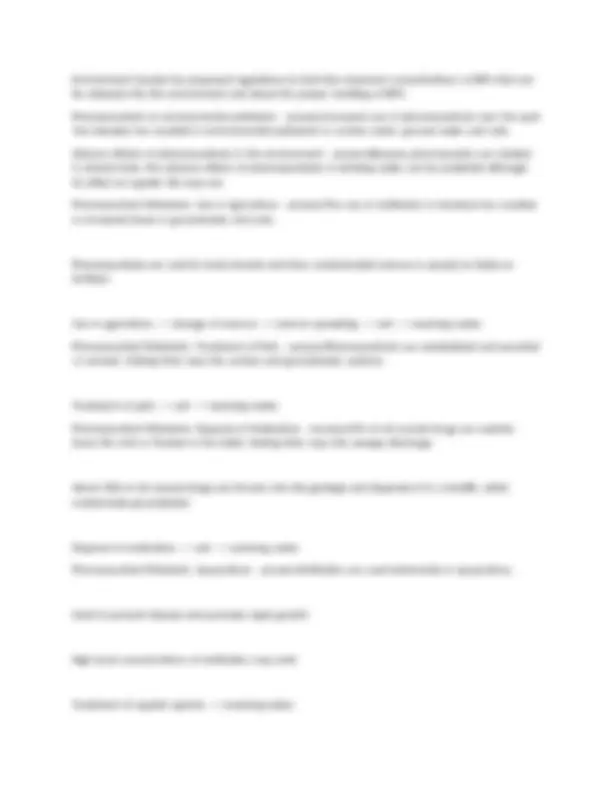
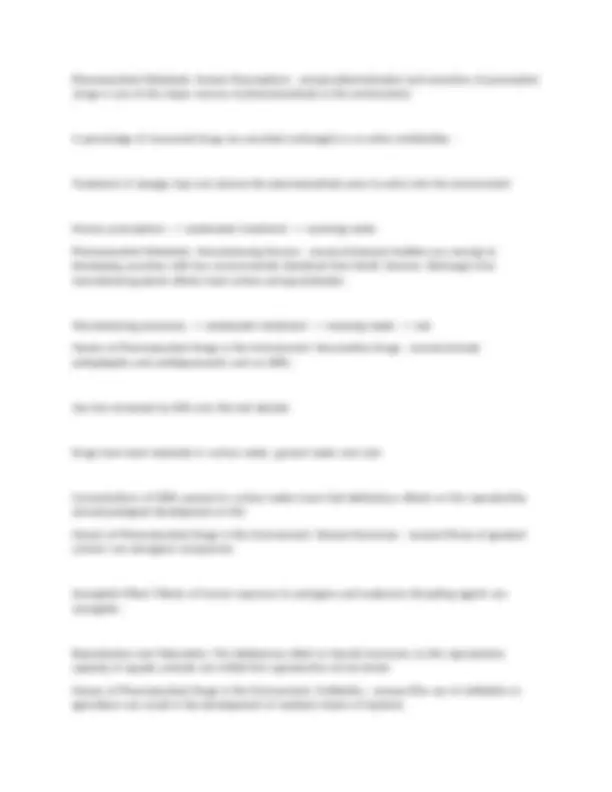
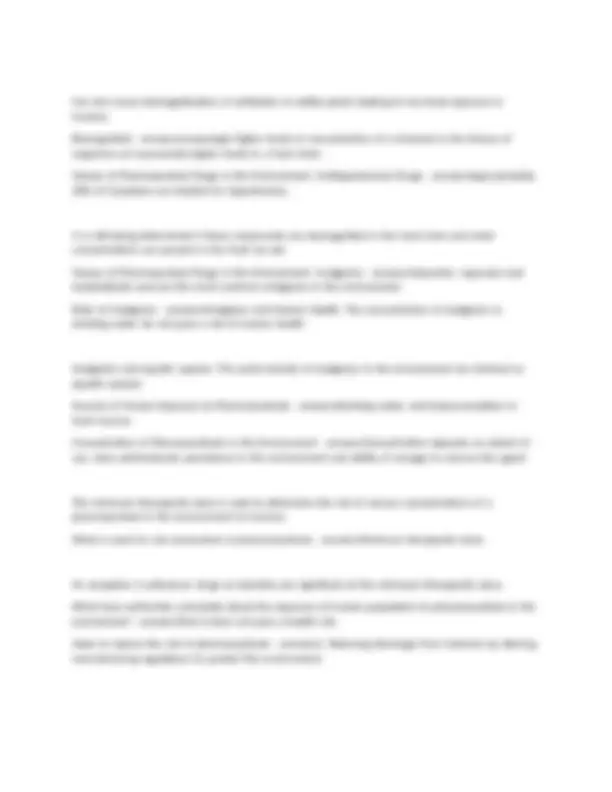
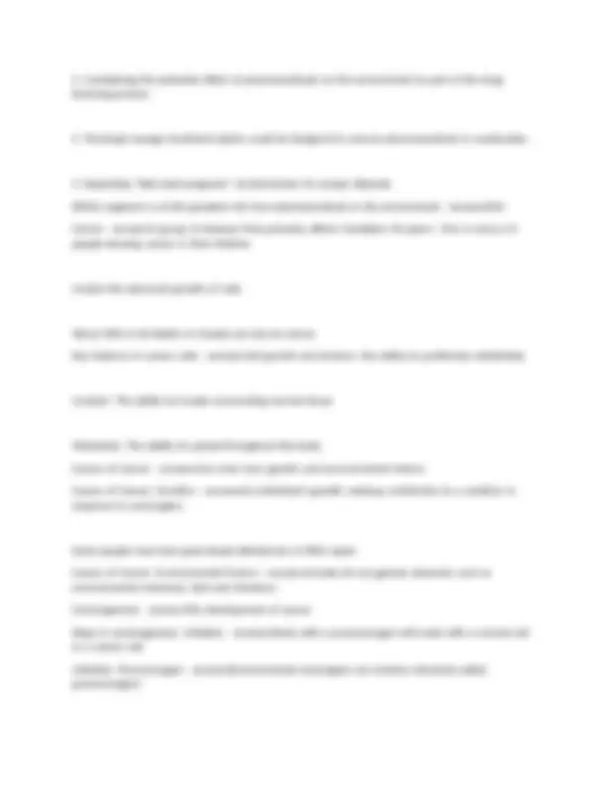
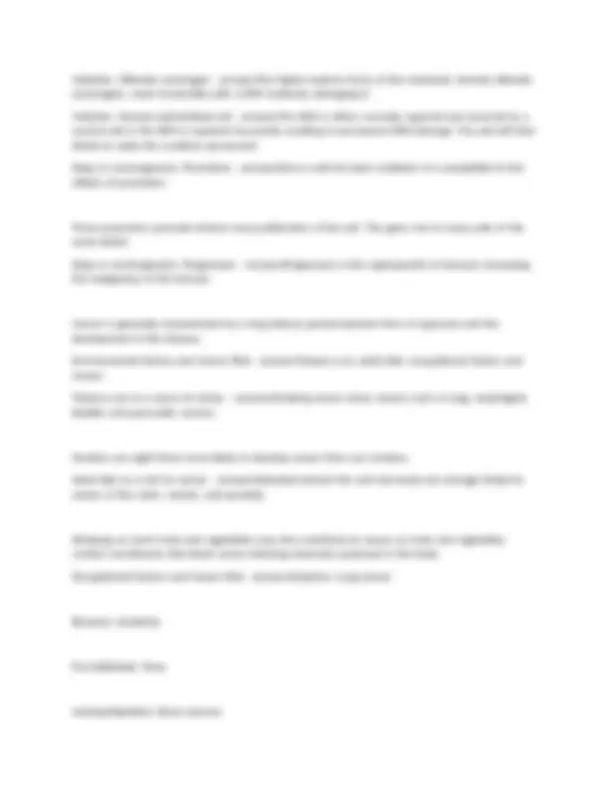




Study with the several resources on Docsity

Earn points by helping other students or get them with a premium plan


Prepare for your exams
Study with the several resources on Docsity

Earn points to download
Earn points by helping other students or get them with a premium plan
Community
Ask the community for help and clear up your study doubts
Discover the best universities in your country according to Docsity users
Free resources
Download our free guides on studying techniques, anxiety management strategies, and thesis advice from Docsity tutors
PHAR 100 – Final Exam University of California,
Typology: Exams
1 / 86

This page cannot be seen from the preview
Don't miss anything!















































































Drugs |- |answersAny |substance |received |by |a.biological |system |that |is |not |received |for |nutritive | purposes |and |which |influences |the |biological |function |of |the |organism. |Means |that |chemicals, | biological |agents |and |herbal |products |are |all |drugs. When |were |the |majority |of |clinically |useful |drugs |developed? |- |answersOver |the |past | 250 |years. Pharmaology |- |answersThe |science |of |drugs, |including |their |uses, |effects |and |mechanisms |of |action. Key |historical |influences |that |have |shaped |modern |pharmacology |- |answersThe |many |discoveries | made |by |ancient |civilizations The |role |of |poisons |in |history. The |influence |of |religion. Ancient |Civilizations |- |answersHealers |existed |in |a |number |of |ancient |cultures |including |Ancient | Greece, |Ancient |Egypt |and |Ancient |China. Ancient |Greece: |Threophastus |- |answersThreophrastus, |a |pupil |of |Aristotle |wrote |a |textbook |on | therapeutics |that |included |opium. Opium |is |obtained |from |the |opium |poppy. Ancient |Greece: |Serturner |- |answersA |pharmacist |working |in |Germany |in |1803. |Isolated |crystals |of | morphine |in |opium |and |tested |the |pure |substance. |Discovered |it |could |relieve |pain. What |does |opium |contain |- |answersMorphine, |codeine Morphine |- |answersOpium |contains |approximately |10% |morphine. |Coined |from |Morpheus. Codeine |- |answersContains |0.5% |codeine. Ancient |Egypt |- |answersrecorded |on |documents |called |papyri. q Ebers |papyrus |- |answers1550 |BCE: |Intended |to |be |a |textbook |of |drug |use |for |medical |students.
The |papyrus |contained |mainy |true |observations |on |the |use |of |drugs, |especially |purgatives. Senna- |still |used |today Ancient |China |- |answersEarliest |recorded |drug |experiments |come |from |China |in |the |year | 2700 |BCE. | Shen |Nung |used |to |classify |drugs |according |to |taste. Ma |Huang |was |classified |as |a |medium |drug. |Widely |used |for |coughs, |influenza |and |fevers. Ephedrine |has |been |isolated |from |Ma |Huang. |Used |to |treat |asthma. |Can |be |used |as |a |decongestant. Poisons: |Curare |- |answersPlant-derived |drug. |Historically |used |by |indigenous |people |in |regions |of |the | Amazon. Curare: |Use |of |a |poison |- |answersIndigenous |peoples |of |the |Amazon |dipped |their |arrows |in |curare |for |hunting. |Acted |upon |voluntary |muscles |causing |paralysis. Curare: |Use |as |a |drug |- |answersUsed |by |Indigenous |People |inspired |allopathic |medicine. |Eventually | used |by |anesthetics |during |surgery. |Small |doses |could |relieve |muscles. |The |structure |has |since |been | modified |to |make |it |safer. Ergot |- |answersA |poisonous |fungus |that |grows |on |the |heads |of |rye. Ground |together |with |rye |in |the |middle |ages, |finding |its |way |into |bread. |Caused |terrible |epidemics, | killing |as |many |as | 20 | 000 |people |in |Russia. Ergot: |Effects |of |Poisoning; |Nervous |System |- |answersOnce |it |enters |the |body, |ergot |targets |the | nervous |system. |Results |in |symptoms |such |as |mental |frenzy, |hallucinations |and |convulsions. Ergot: |Effects |of |Poisoning; |Cariovascular |System |- |answersErgot |poisoning |can |cause |constrictions |of | blood |vessels |leading |to |fingers, |toes |and |limbs |becoming |starved |of |their |blood |supply. Ergot: |Effects |of |Poisoning; |Reproductive |System |- |answersCan |cause |violent |contractions |of |the | uterus. Some |midwives |recognized |that |small |amounts |of |ergot |could |be |useful |in |hastening |labour. |Used |as | early |as |the |16th |century. Physicians |in |the |1800s |used |ergot |to |expedite |lingering |labour. |Could |result |in |death. Ergot: |Use |as |a |drug |- |answersErgotamine |and |ergonovine |are |the |two |compounds |derived |from | ergot |with |pharmocological |uses.
LSD |- |answersLysergic |Acid |Diethylamide. Classified |as |a |controlled |substance |in |the |1970s. Drugs |Acting |On |the |Brain: |Contribution |to |Pharmacology |- |answersDiscovery |of |LSD |psychedelic | effects |supported |the |idea |that |certain |mental |illnesses |may |be |due |to |the |production |of |potent | substances |of |the |brain |that |produced |distrubance. Drugs |Acting |Against |Infectious |Disease |- |answersAn |infectious |disease |is |any |disease |caused |by |an | organism. 1900s |Organoarsenicals |- |answersPaul |Ehrlich: |Designed |complexes |of |arsenic |and |organic |molecules | called |orsanoarsenicals |which |selectively |bound |to |parasites. | Applied |to |other |infectious |diseases |and |led |to |cure |for |syphilis. Syphilis |- |answersA |bacterial |infection |transmitted |sexually |through |direct |contact |with |a |syphilis |sore. |Easy |to |cure |when |diagnosed |and |treated |early. 1930s: |Sulfa |Drugs |- |answersGerhard |Domagk |introduced |sulfa |drugs |in |1930s |Germany. First |synthetic |drug |used |for |treatment |of |bacterial |disease. Now |termed |antibacterial |compounds. 1940s: |Penicillin |- |answersAlexander |Fleming |discovered |penicilin, |the |first |antibiotic. Introduction |to |modern |medicine |occurred |during |WWII Majorly |used |in |gram-positive |bacterial |disease. Gram-positive |- |answersBacteria |with |thick |cell |walls |and |no |outer |membrane. 1950s: |Streptomycin |- |answersSelman |Waksman |discovered |streptomycin. |Helped |to |treat |Gram- negative |bacterial |diseases |and |tuberculosis. Gram-negative |- |answersBacteria |with |thin |cell |walls |and |an |outer |membrane. Drug |development |process |steps |- |answersBasic |research |and |drug |discovery, |preclinical |trials, |clinical |trials, |Health |Canada |review |and |manufacturing, |post-market |surveillance |and |phase |IV |clinical |trials 3-6 |years |- |answersBasic |research |and |drug |discovery |and |preclinical |trials
6-7 |years |- |answersClinical |trials | -Phase |1: |10s |of |patients |enrolled |in |study. -Phase |2: |100s |of |patients -Phase |3: |1000s |of |patients 0.5-2 |years |- |answersHealth |Canada |Review |and |Manufacturing Continuous |- |answersPost-market |surveillance |and |phase |IV |clinical |drug |trials. Drug |Discovery: |Basic |Research |and |Discovery |of |Target Step |1: |Identification |of |the |Target |- |answersA |target |for |a |new |potential |drug |could |be |a |receptor | that |causes |pain |relief |when |activated. | When |a |compound |that |binds |well |to |the |target |is |found, |it |an |then |be |studied |to |determine |its | pharmacological |effects. Drug |Discovery: |Basic |Research |and |Discovery |of |Target Step |2: |Studying |the |Target |- |answersLead |compounds |are |compounds |that |show |promise |in |the | initial |studies. Enter |more |detailed |studies |for |safety |and |efficacy. Effficacy |- |answersThe |maximum |pharmacological |response |that |can |be |produced |by |a |specific |drug |in |that |biological |system. Preclinical |Studies |- |answersConducted |prior |to |testing |the |drug |in |humans. |Can |measure |molecules/cells, |tissues |or |whole |animals |studies. Two |types |of |clinical |studies |- |answersPharmacology |studies, |toxicology |studies Pharmacology |studies |- |answersDetermine |the |detailed |mechanism |of |action |of |the |drug. Toxicology |Studies |- |answersDetermine |the |potential |risks |or |harmful |effects |of |the |drug. | Can |look |at |acute |toxicity, |chronic |toxicity, |and |effects |on |reproductive, |carcinogenic, |and |mutagenic | potential. Can |take |up |to | 6 |years |to |complete.
Goal: |Determine |the |safety |and |efficacy |of |the |drug |compared |to |the |placebo/gold |standard |drug. Duration: |Longer |than |phase | 2 |studies Location: |Studies |are |conducted |at |centres |in |many |cities. |One |centre |often |does |not |have |enough | diversity. Cost: |May |cost |one |million |to |upwards |of | 50 |million |dollars. Design |of |Phase |three |clinical |trials |- |answersThree |larger |stages: Determining |enrolment |prior |to |the |study Allocating |participants |to |treatment |groups |and |conducting |the |trial. Monitoring |and |analyzing |the |results. Hypertension |- |answersHigh |blood |pressure Enrolment |- |answersThe |target |population |is |the |group |of |patients |for |which |the |drug |is |intended. |A | subset |of |the |target |population |that |meets |all |required |criteria |is |the |study |population. Inclusion |in |the |study |population |is |determined |by |both |inclusion/exclusion |criteria |and |consent | influence. Inclusion |Exclusion |criteria |- |answersCharacteristics |of |the |patients |to |be |included |in |the |study, | determining |who |is |and |who |is |not |eligible |to |be |part |of |the |trials. Common |comorbidities |are |often |included. Comorbidities |- |answersOne |or |more |conditions |present |in |addition |to |the |primary |condition, Treatment |Allocation |- |answersDouble |blind |design, |randomization, |control Double |blind |design |- |answersNeither |the |investigator |nor |the |study |subject |is |aware |of |the | treatment |the |study |subject |is |assigned |to. |Bias |can |occur |if |a |study |subject |believes |the |drug |will | work |or |an |investigator |may |expect |positive |results.
Randomization |- |answersPatients |assigned |to |either |a |treatment |group |or |a |control |group. |Assigned | using |a |process |known |as |randomization. |Helps |to |ensure |the |confounding |variables |(known |and | unknown) |are |distributed |equally |between |both |groups |and |removes |bias |from |assigning |patients. Control |- |answersEither |a |placebo |or |a |gold |standard |drug. |Used |to |compare |the |actual |efficacy |of | the |experimental |drug. Placebo |- |answersDoes |not |contain |an |active |drug |but |is |administered |the |same |as |the |experimental | drug. |The |placebo |response |can |be |as |high |as |40% |since |people |expect |themselves |to |feel |better. Gold |standard |- |answersThe |drug |accepted |by |the |medical |community |as |the |best |available |treatment |for |the |specific |disease |at |that |time. |The |control |group |will |receive |this |if |available |as |it |is |unethical | to |withhold |treatment. Health |Canada |Review |- |answersThe |manufacturer |will |submit |a |new |drug |application |containing |the | detailed |results |of |the |clinical |trials. |The |drug |is |reviews |by |regulatory |scientists |and |can |then |be | granted |approval. Manufacturing: |Generic |and |Brand |name |- |answersA |drug's |formal |chemical |name |is |too |complex |for | common |use. |A |generic |name |for |the |drug |is |selected |while |at |the |same |time, |the |manufacturer |will | apply |for |a |patent |with |a |brand |name |for |the |drug, |which |will |give |the |company |rights |to |market |the | drug. What |must |any |generic |versions |of |the |original |drug |contain? |- |answersIdentical |active |ingredients |in | the |same |amount |and |form Bioequivalent |- |answersThe |same |active |ingredients |are |contained |in |two |drug |products |which |give | similar |blood |levels. Post-Market |Surveillance |- |answersRisks |that |are |delayed |or |less |frequent |than |1/1000 | administrations |may |be |missed |in |phase |three |clinical |trials. |Surveillance |of |the |effects |of |the |drugs |is |required |after |the |drug |is |released |for |general |use. |(Figures |out |how |they're |reacting |or |affecting | certain |groups) What |factors |must |one |look |at |to |see |the |effects |of |drugs |on |the |body? |- |answersDrug |targets Drug |response Efficacy |and |potency Therapeutic |range. Receptors |- |answersA |molecule |or |complex |of |molecules |on |the |outside/inside |of |a |cell |that |has |a | regulatory |or |functional |role |in |the |organism. Many |of |the |same |receptors |may |exist |on |a |single |cell |and |many |of |the |same |cell |types |exist |in |an | organism.
Efficacy |- |answersThe |maximum |pharmacological |response |that |can |be |produced |by |a |specific |drug |in | that |biological |system. Potency |- |answersThe |dose |of |a |drug |that |is |required |to |produce |a |response |of |a |certain |magnitude, | usually |50% |of |the |maximal |response |for |that |drug. Therapeutic |Range |- |answersDrugs |are |administered |to |achieve |a |therapeutic |effect. The |aim |of |therapy |is |to |give |a |dose |that |keeps |the |blood |concentration |above |the |minimum | concentration |to |produce |a |desirable |response |while |keeping |it |below |the |concentration |that | produces |a |toxic |response. Pharmacokinetics |- |answersRefers |to |the |movement |of |a |drug |into, |through |and |out |the |body. Processes |Involved |in |Pharmacokinetics |- |answersAdministration |of |a |drug |can |happen |through |three | routes: |topical, |enteral |and |parenteral. Four |key |processes |occur |after |administration: |absorption, |distribution, |metabolism |and |excretion | (ADME). Routes |of |Administration |- |answersTopical: |Drugs |that |are |applied |directly |to |a |particular |place |on |or | in |the |body. |This |can |be |on |the |kin, |through |the |skin, |or |through |inhalation. Enteral: |Refers |to |administration |via |the |GI |tract. |Can |be |directly |via |the |mouth |or |an |artificial | opening. |Routes |of |administration |include |mouth, |rectum, |sublingual |and |buccal. -Sublingual |is |under |the |tongue. -Buccal |is |in |the |cheek. Parenteral: |Refers |to |administration |bypassing |the |GI |tract. |Routes |of |administration |include | intravenous, |intramuscular |and |subcutaneous. Topical |Administration |on |the |Skin |- |answersDrugs |applied |to |the |skin |are |used |to |treat |mild |to | moderate |skin |conditions |including |eczema, |acne |and |infections. |Drugs |applied |to |the |skin |for |local | effect |can |be |absorbed |and |produce |a |systemic |effect. Systemic |Effect |- |answersA |descriptor |used |to |indicate |something |that |affects |the |whole |body |or | multiple |organ |systems. Through |the |Skin: |Transdermal |- |answersAllows |for |absorption |into |the |general |circulation |for | systemic |effect. |Although |it |can |be |expensive |or |cause |local |irritation, |it |is |also |convenient, |delivers |a | steady |drug |supply |for |several |days |(eliminates |frequent |oral |dosing), |and |bypasses |the |enzymes |of | the |stomach, |intestine, |and |liver.z
Inhalation |- |answersInhaled |drugs |can |be |rapidly |absorbed |into |the |lungs. |Used |for |both |local |and | systemic |effects. Ex. |Gaseous |anesthetics |(systemic), |steroid |and |other |drugs |(local |effects |in |lungs) Quantities |of |drugs |for |local |effect |are |small |and |often |less |than |required |for |systemic |effect. Disadvantage: |requires |proper |use |by |the |patient. Enteral |Administration |- |answersEnter |the |blood |through |the |gastrointestinal |tract. First |delivered |to |the |liver |which |contains |enzymes |that |can |decrease |the |amount |of |active |drug |left | to |enter |the |general |circulation. |Called |the |first |pass |effect. Mouth |Administration |Advantages |- |answersThe |mouth |is |commonly |used |to |administer |drugs. |>90% | of |all |drugs |are |taken |by |this |route. Most |convenient |and |least |expensive |means |of |taking |a |drug Non-invasive |and |can |be |self-administered Mouth |Administration |Disadvantages |- |answersVariable |absorption |between |patients |due |to | differences |in |intestinal |motility |and |disease. Rectum |administration |advantages |- |answersCan |be |for |systemic |or |local |effect Can |be |used |in |patients |who |are |nauseated |or |vomiting, |or |as |a |less |invasive |route |for |those |who |are |comatose. Digestive |enzymes |of |the |stomach |and |intestines |are |bypassed Rectum |Administration |Disadvantages |- |answersOnly |a |limited |number |of |medications |are |available |or |suitable |for |rectal |administration. Absorption |from |the |rectal |mucosa |is |slow, |incomplete |and |variable, |depending |on |the |time |the | medication |is |retained.
Rapid |(1-2 |minutes) |30-100% Intermediate |(3-4 |minutes) |30-100% Parenteral |- |answers15-30 |seconds; |100% 10-20 |minutes; |75-100% 15-30 |minutes; |75-100% ADME: |Absorption |- |answersDefined |as |the |movement |of |a |drug |from |the |site |of |administration |into | the |blood. Must |be |able |to |cross |the |biological |membrane |for |sites |of |action, |storage |and |excretion. Drugs |can |cross |membranes, |moving |from |one |side, |the |lumen, |to |the |other |side, |the |interstitium. Absorption: |Diffusion |through |aqueous |pores |- |answersDrugs |with |small |molecular |weights |that |are | water |soluble |can |move |across |membranes |by |dissolving |in |the |fluids |surrounding |the |cell |and |then | passing |through |the |small |openings. |From |high |to |low |concentration. Absorption: |Diffusion |through |lipids |- |answersCellular |membranes |are |composed |of |a |lipid |bilayer | structure. |They |pass |through |the |membrane |by |dissolving |in |the |lipid |portion |of |the |membrane. | These |drugs |still |flow |down |a |concentration |gradient. Absorption: |Active/carrier |mediated |transport. |- |answersDrugs |bind |to |proteins, |which |carry | molecules |across |the |membrane. |Once |bound, |the |carrier |protein-drug |complex |moves |across |the | membrane |and |releases |the |drug |on |the |other |side |of |the |membrane. |Can |move |down |a | concentration |gradient |but |can |also |be |an |active |process, |using |energy |to |move |against |a | concentration |gradient. Distribution |- |answersDefined |as |the |movement |of |a |drug |from |the |blood |to |the |site |of |action |and | other |tissues. Most |drugs |reach |all |tissues |and |organs |regardless |of |the |target |site. |Concentrations |of |drug |at |the | sites |of |distribution |are |in |equilibrium |with |its |concentration |in |the |blood. Blood |flow |determines |the |rate |at |which |drugs |are |distributed |in |and |out |of |a |particular |organ. Thiopental |- |answersAn |ultra-short |acting |sedative |which |functions |to |rapidly |induce |anesthesia.
How |can |distribution |result |in |the |termination |of |therapeutic |effect? |- |answersDistribution |of | thiopental |in |the |brain |is |high |and |low |in |muscles |and |fat. |As |more |drug |distributes |into |the |muscles | and |fat, |the |concentration |in |blood |will |decreased |causing |the |drug |to |leave |the |brain |and |move |into | the |blood. |Causes |patient |to |awaken. Metabolism |(Biotransformation) |- |answersDrug |metabolism, |or |biotransformation, |is |the |conversion | of |a |drug |to |a |different |chemical |compound |in |order |to |eliminate |it. The |products |of |metabolism |are |metabolites |and |are |usually |devoid |of |pharmacological |action. Drug |must |be |water |soluble |to |be |eliminated |by |the |kidneys. |Most |drugs |must |be |converted |to |more | water |soluble |forms. |Chemicals |that |are |lipid-soluble |will |never |be |excreted |from |the |body |without | metabolism. Biotransformation |often |occurs |in |the |liver |but |can |also |occur |in |the |kidneys, |intestines, |lungs, |skin | etc. Metabolites |- |answersThe |products |of |metabolism |are |metabolites |and |are |usually |devoid |of | pharmacological |action. Biotransformation |Reactions: |P450 |- |answersEnzymes |capable |of |biotransforming |drugs. |Present |in | high |concentrations |in |the |liver |but |found |in |most |tissues. |Cytochrome |P450 |family |of |enzymes | biotransforms |the |vast |majority |of |clinically |used |drugs. Biotransformation |Reactions: |Phase | 1 |- |answersPurpose |of |phase | 1 |reaction |is |to |add |or |unmask |a | functional |group |on |the |drug |to |prepare |it |for |the |addition |of |a |large |water-soluble |molecule |in |the | phase | 2 |reaction. Biotransformation |Reactions: |Phase | 2 |- |answersAdds |a |large |water-soluble |moiety |(A |part |or | functional |group |of |the |molecule) |to |the |product |resulting |from |phase | 1 |biotransformation, |making | the |metabolite |water-soluble |for |excretion |by |kidney. Biotransformation |Reactions: |Excretion |- |answersMoving |the |drug |and |its |metabolites |out |of |the | body. |All |body |fluids |will |contain |drugs |and |their |metabolites. Excretion: |Kidney |- |answersThe |majority |of |drugs |are |eliminated |by |the |kidney. |Drugs |of |sufficient | water |solubility |will |be |excreted |in |the |urine. |Lipid-soluble |drugs |can |be |reabsorbed |from |the |kidney | back |into |the |blood. Excretion: |GI |Tract |- |answersSome |drugs |can |be |excreted |by |the |gastrointestinal |tract |after |they | undergo |biotransformation |in |the |liver. Excretion: |Lungs |- |answersDrugs |that |are |volatile |or |in |a |gaseous |form |can |be |excreted |by |the |lungs.
Length |of |usage: |Toxic |reaction |may |only |be |present |after |long |term |use. Detectability |in |Animals: |Toxic |effect |may |only |appear |once |the |drug |is |being |tested |in |humans. Time |period |specificity: |may |only |cause |issues |in |pregnant |people. Therapeutic |Index |- |answersTI, |Tells |you |how |safe |the |drug |is. |Relates |the |dose |of |the |drug |required | to |produce |a |beneficial |effect |to |the |dose |required |to |produce |an |undesirable |or |adverse |effect. |The | higher |the |therapeutic |index, |the |safer |the |drug. Toxic |Dose | 50 |(TD50) |- |answersThe |dose |of |drug |that |is |toxic |in |50% |of |the |population. Effective |Dose | 50 |(ED50) |- |answersThe |ED50 |is |the |dose |of |drug |that |is |effective |in |50% |of |the | population. How |to |calculate |therapeutic |index |- |answersTI |= |TD50 |/ |ED Drug-Drug |Interactions |- |answersOccurs |when |one |drug |changes |the |pharmacological |effect |of |a | second |drug. Drug-Drug |Interactions: |Absorption |- |answersA |drug |can |increase |intestinal |movement, |speeding |the | passage |of |a |second |drug |through |the |intestine |and |decreasing |contact |of |the |second |drug |with |the | intestinal |wall. |Decreases |absorption. Drug-Drug |Interactions: |Metabolism |- |answersA |drug |can |block |the |inactivation |of |a |second |drug |in | the |liver, |increasing |the |blood |level |and |pharmacological |effect |of |the |second |drug. Drug-Drug |Interactions: |Excretion |- |answersA |drug |can |facilitate |the |excretion |of |a |second |drug |by |the |kidney, |decreasing |the |blood |level |and |pharmacological |effect |of |the |second |drug. Drug-Food |Interactions: |Tyramine |- |answersTyramine: |Found |in |well-matured |cheeses. |Capable |of | raising |blood |pressure |and |broken |down |in |the |liver |by |an |enzyme |known |as |monoamine |oxidase | MAO. |One |class |of |antidepressant |drugs |are |inhibitors |of |MAO. |If |a |patient |consumes |food |containing |tyramine |while |on |these |antidepressants, |the |tyramine |will |not |be |broken |down |to |inactive |products | and |the |blood |pressure |raising |effects |of |tyramine |will |be |intensified. Drug-Food |Interactions |- |answersAlter |the |absorption |of |some |drugs. |A |number |of |drugs |are | biotransformed |and |inactivated |by |metabolizing |enzymes |in |the |GI |tract. |Grapefruit |inhibits |these | enzymes, |meaning |more |active |drug |is |absorbed. |Higher |blood |levels |of |drug |than |expected |can |lead | to |overdose. The |Cerebral |Cortex |- |answerslargest |part |of |the |brain |and |very |rich |in |neurons. |Overall |functions |are: |sensory |and |motor |coordination, |mental |processes, |intelligence, |memory, |vision |judgement, |thought, | speech, |emotions |and |consciousness. |Can |be |stimulated |or |inhibited |by |drugs.
Limbic |System |- |answersA |region |of |the |brain |that |integrates |memory, |emotion, |and |reward. |Controls |emotion |and |behavior |with |the |hypothalamus. |Contains |the |dopaminergic |reward |centers, |which |are | targets |for |commonly |misused |drugs |and |are |associated |with |addiction. The |neuron |- |answersThe |functional |unit |of |the |brain. Capable |of |generating |and |transmitting |electrical |signals. |Brain |contains | 90 |billion |neurons. New |neurons |generated |through |neurogenesis.Neuroplasticity |constantly |reshapes |neurons. Structure |of |the |neuron: |Dendrites |- |answersShort |and |highly |complex |branching |patterns |which | receive |incoming |information |and |accept |information |through |receptors |located |on |dendritic | membranes. |An |electric |current |is |generated |and |directed |down |the |neuron |upon |receiving |this | information. Structure |of |the |neuron: |Cell |body |- |answersSoma, |largest |part |of |the |neuron, |contains |nucleus |and | surrounding |cytoplasm. |Contains |neurotransmitters |which |can |be |secreted. Structure |of |the |neuron: |Axon |- |answersA |single |fiber |that |extends |from |the |cell |body |and |ends |at |a | synapse. |Axon |continues |to |carry |the |incoming |info |away |from |the |dendrites |and |cell |body. | Information |passed |to |subsequent |neurons. Synapse |- |answersAn |electrical |impulse |has |to |be |communicated |from |one |neuron |to |another |to | produce |an |effect. |The |junction |between |two |neurons |is |called |a |synapse. |It |is |the |area |where |one | neuron's |axon |ends |and |another |neuron's |dendrite |or |cell |body |begins. Neurotransmission |- |answersThe |passage |of |a |signal |from |one |neuron |to |another, |also |called | neurotransmission. |How |neurons |communicate. |Also |called |synaptic |transmission Very |rapid |and |chemical |in |nature. |A |substance |is |released |quickly |that |activates |the |next |neuron. Neurotransmitters |- |answersThe |endogenous |chemicals |that |transmit |a |signal |between |two |neurons | are |called |neurotransmitters. How |many |synaptic |connections |can |a |neuron |make |- |answersOne |synapse |connects |two |neurons | normally. |However, |a |single |neuron |can |make |synaptic |connections |with |many |other |neurons. How |does |synaptic |transmission |occur |- |answersAn |electrical |impulse |travels |down |the |axon |of |a | neuron. |When |the |electrical |impulse |reaches |the |end |of |the |presynaptic |neuron, |it |causes |the | vesicles, |which |contain |neurotransmitters, |to |fuse |with |the |presynaptic |membrane, |thereby |releasing | the |neurotransmitters |into |the |synaptic |cleft. |The |neurotransmitters |will |then |diffuse |across |the | synaptic |cleft |and |bind |with |receptors |on |the |postsynaptic |membrane. |Activation |of |these |receptors | changes |the |membrane |permeability, |allowing |ions |such |as |calcium |to |move |into |the |postsynaptic | neuron. |This |generates |an |electrical |impulse |which |travels |down |that |neuron's |axon. |The |process | continues |until |the |neuronal |signal |reaches |the |target |organ, |causing |an |effect.
Neurotransmitters |and |Receptors: |Opioid |Peptides |- |answersEnkephalins, |endorphins, |and |dynorphins. |Have |varying |degrees |of |selectivity |for |the |three |opioid |receptors: |mu, |delta, |kappa. Opioid |Crisis |- |answersFrom |January | 2016 |to |September |2020, | 19 | 355 |Canadians |died |of |apparent | opioid |overdose. |A |life |was |lost |every | 2 |hours, | 94 |% |of |which |were |accidental. 70% |of |those |occur |in |those |younger |than |50. SUD |- |answersSubstance |Use |Disorder |- |Defined |by |a |number |of |criteria. |Two |or |more |of |the |criteria | is |enough |to |classify |for |a |mild |SUD. SUD: |Social |Impairments |- |answersThe |individual |fails |to |fulfill |major |roles |and/or |has |persistent |social |or |interpersonal |problems. |Social, |occupational |or |recreational |activities |may |be |given |up |or |reduced. SUD: |Risky |Use |- |answersIndividual |may |use |the |substance |in |physically |hazardous |situations |or |use | the |substance |despite |physiological |or |psychological |problems |caused |by |the |use. SUD: |Impaired |Control |- |answersThe |individual |may |have |persistent |cravings |for |the |substance. SUD: |Withdrawal |- |answersThe |individual |may |experience |withdrawal |syndrome |after |stopping |use. Syndrome |- |answersA |group |of |signs |and |symptoms |occurring |together |that |characterize |a |particular | abnormality |or |condition. SUD: |Tolerance |- |answersThe |individual |may |develop |a |tolerance |to |the |substance. Addiction |- |answersImpaired |control |manifests |as |emotional |and |mental |preoccupation |with |the | drug's |effects |and |a |persistent |craving |of |the |drug. It |is |a |state |at |which |stopping |or |abruptly |reducing |the |dose |of |a |drug |produces |non-physical | symptoms. The |Dopamine |Hypothesis |- |answersThe |predominant |hypothesis |to |explain |addiction. The |Dopamine |Hypothesis: |Effect |on |reward |systems |- |answersCommonly |misused |drugs |increase | dopamine |in |the |rewards |system |of |the |brain. |(limbic |system) Although |other |neurotransmitters |are |involved, |the |increase |in |dopamine |appears |to |be |a |key | component. The |Dopamine |Hypothesis: |Dopamine |increase |- |answersDopaminergic |systems |are |responsible |for | natural |rewards |such |as |food |or |sex |and |stimulus |related |rewards |such |as |video |games |or |gambling. Drugs |associated |with |addiction |cause |an |exaggerated |increase |in |dopamine.
Characteristics |of |Addictive |Drugs, |can |be |classified |into |three |categories |based |on |the |effects |they | produced. |- |answersIncrease |Dopamine: |Both |Central |Nervous |System |Stimulants |(cocaine, | amphetamines, |nicotine |and |caffeine) |and |Opioids |(Morphine, |heroin |and |oxytocin), |as |well |as | alcohol/cannabis |can |increase |dopamine |in |brain |reward |systems. Produce |Novelty: |Some |drugs |are |addictive |because |they |produce |a |novel |feeling |in |the |person |taking |it. |These |include |Lysergic |acid |diethylamide |(LSD), |ecstasy/MDMA Reduce |Anxiety: |Some |drugs |are |addictive |because |they |reduce |anxiety. |These |include |CNS | depressants |such |as |benzodiazepines |and |barbiturates. Drug |Withdrawal |- |answersAn |abnormal |psychological |state |produced |by |repeated |administration |of |a |drug |that |leads |to |the |appearance |of |a |withdrawal |system |when |this |administration |is |discontinued | or |decreased. Severity |of |withdrawal |syndrome |increases |with |the |speed |of |a |drug |withdrawal. The |fear |of |withdrawal |continues |a |cycle |of |drug |taking |behavior. Drugs |and |their |Withdrawal |Symptoms |- |answersWithdrawal |symptoms |are |often |opposite |to |the | effects |of |the |drug. Withdrawal |Symptoms: |Stimulants |- |answersCommon |stimulant |drugs |are |cocaine |and |amphetamines. |Symptoms |include: |sleepiness, |muscle |pain, |anxiety, |tremors, |low |mood, |suicidal |ideations, | cardiovascular |problems. Withdrawal |Symptoms: |Opioids |- |answersCommon |opioids |include |heroin, |morphine |and |pain | medication |such |as |oxycodone. |Symptoms |include |sweating, |muscle |aches, |agitation, |diarrhea, | abdominal |cramping, |vomiting. Drug |Tolerance |- |answersA |shortened |duration |of |action |and |a |decreased |magnitude |of |effect The |extent |and |rate |of |development |of |tolerance |is |specific |for |each |drug. Does |not |develop |to |all |drugs. Is |reversible |upon |drug |discontinuation. Cross |Tolerance |- |answersCan |occur |between |pharmacologically |similar |drugs. Defined |as |a |resistance |or |tolerance |to |one |drug |because |of |resistance |or |tolerance |to |a |similar |drug.